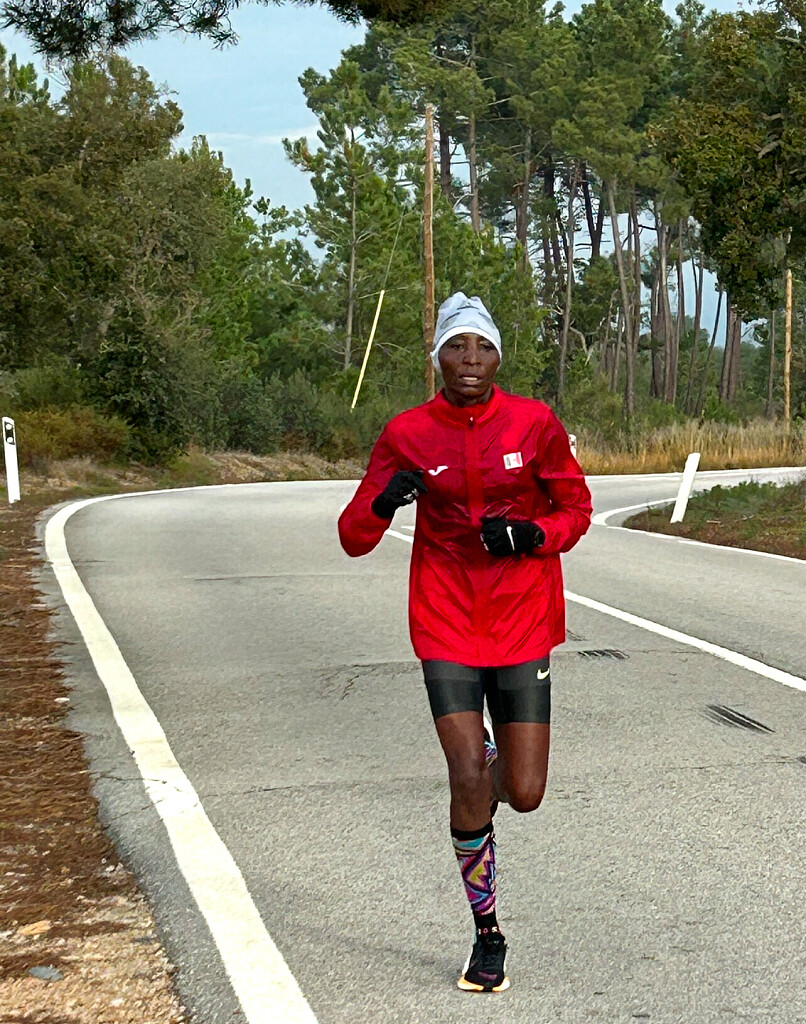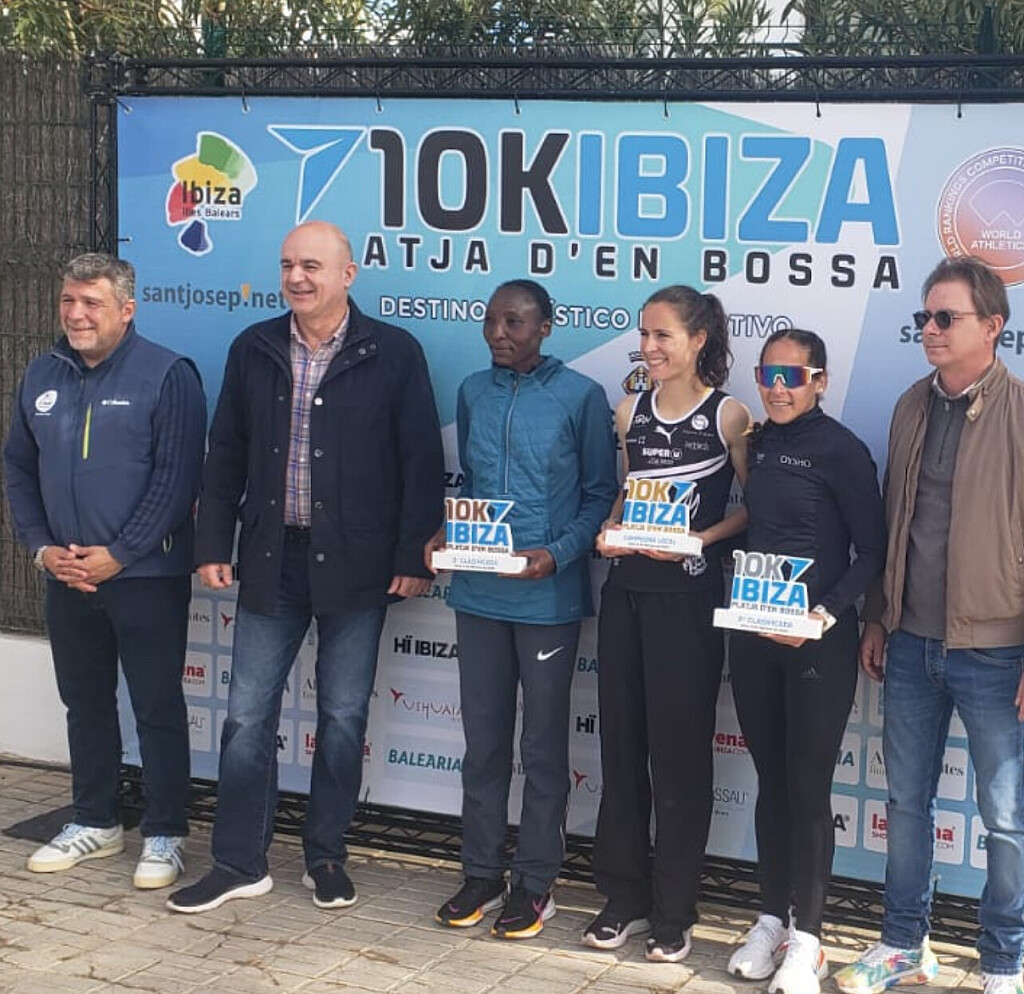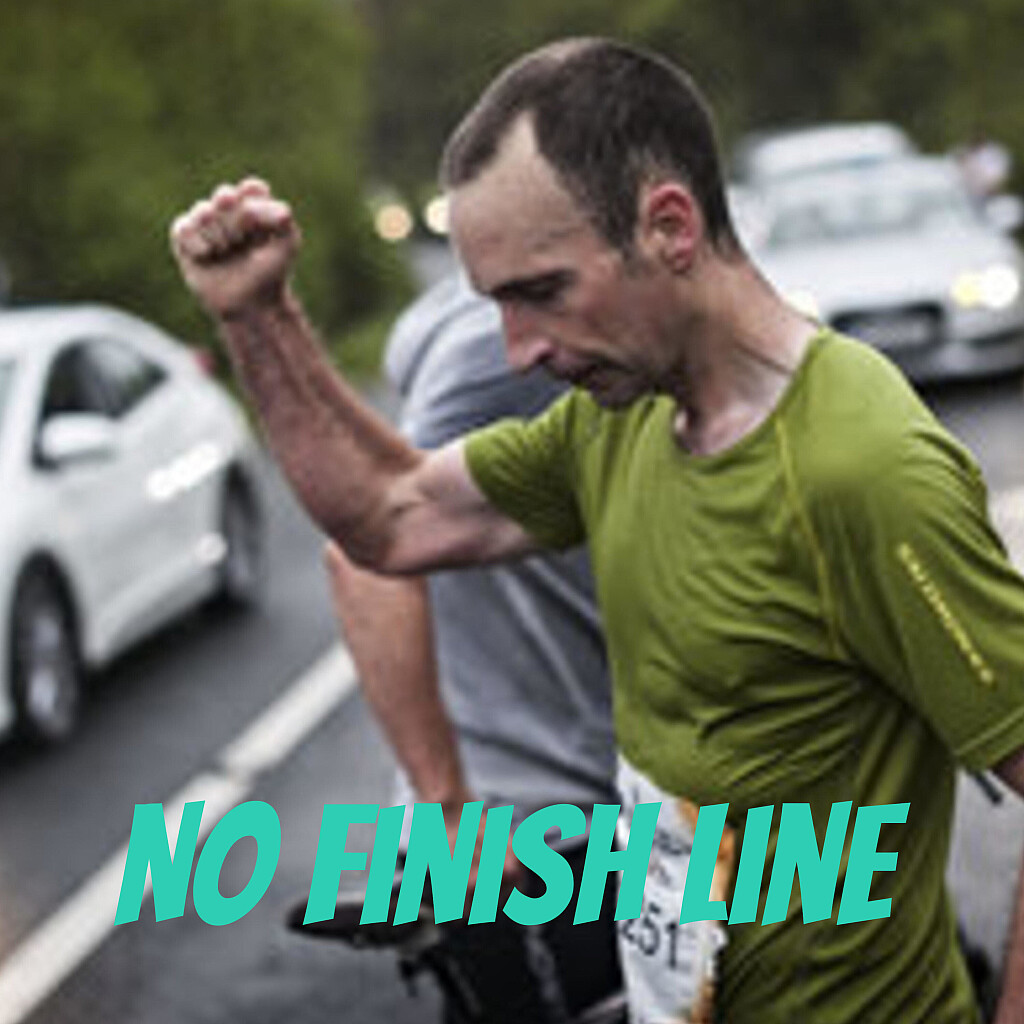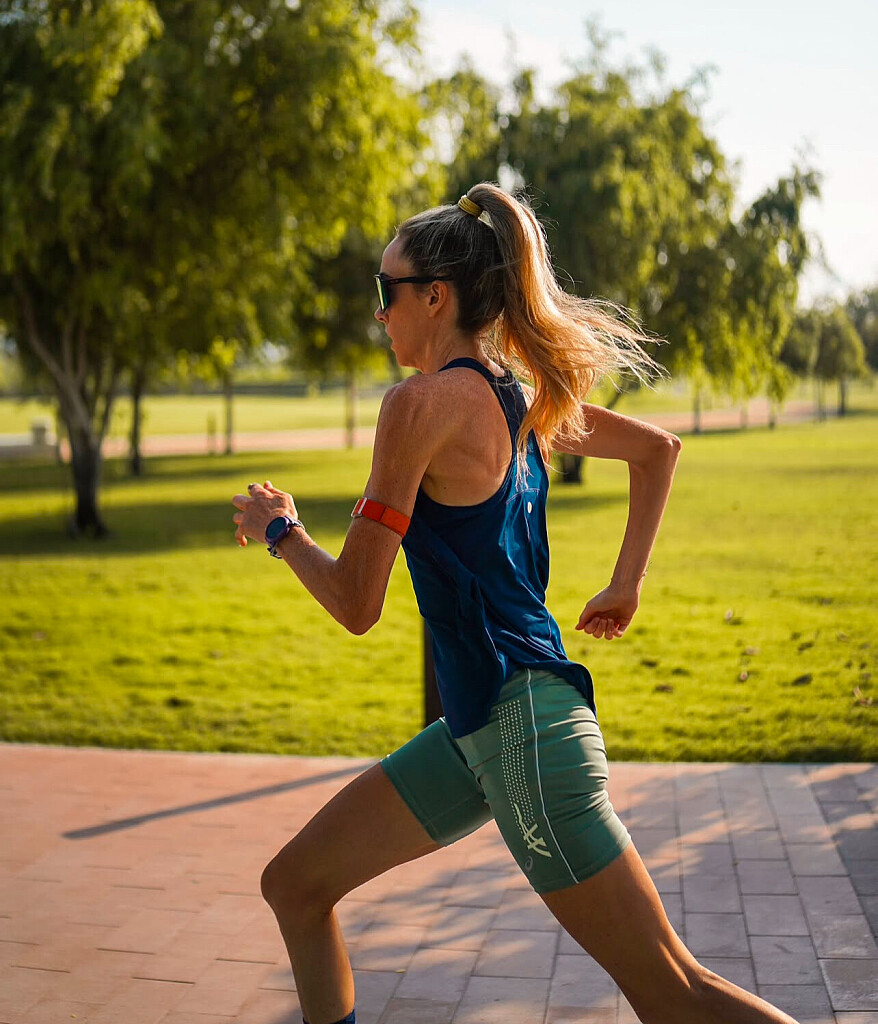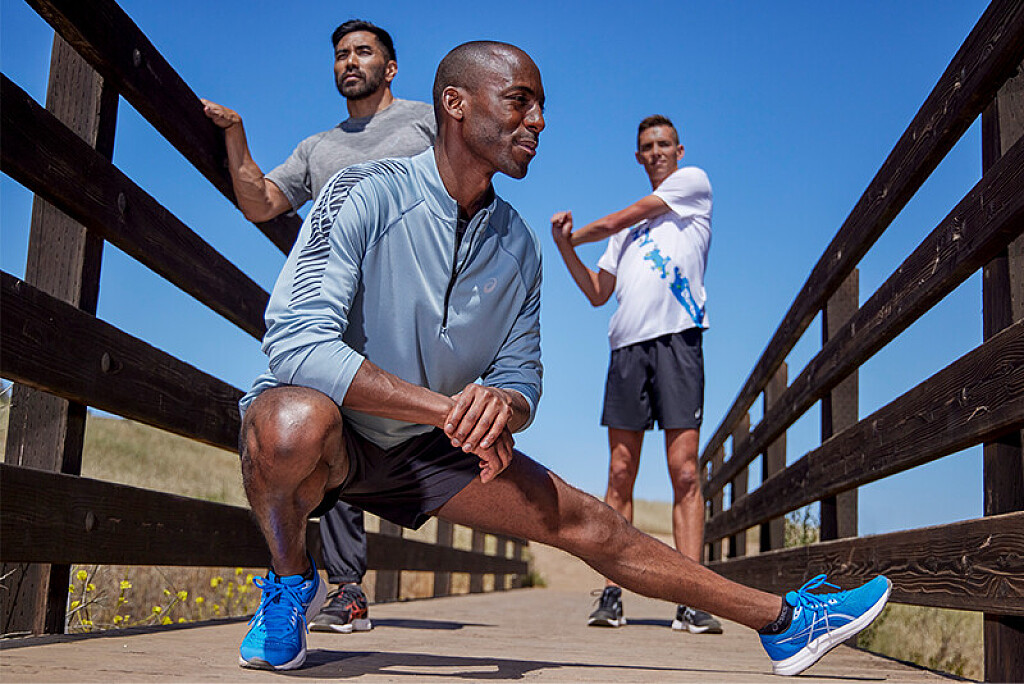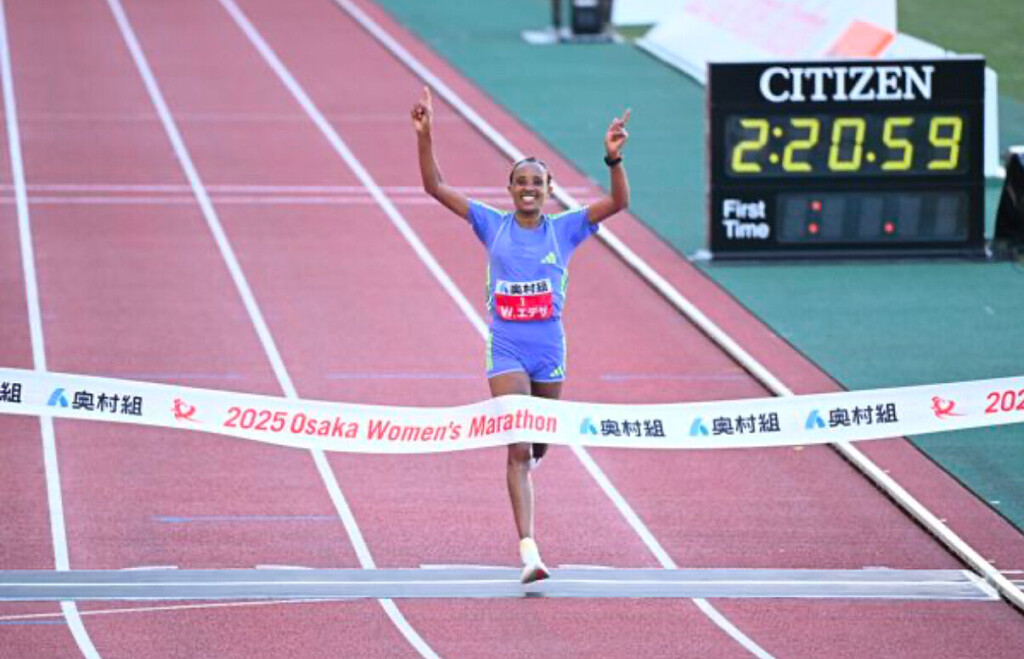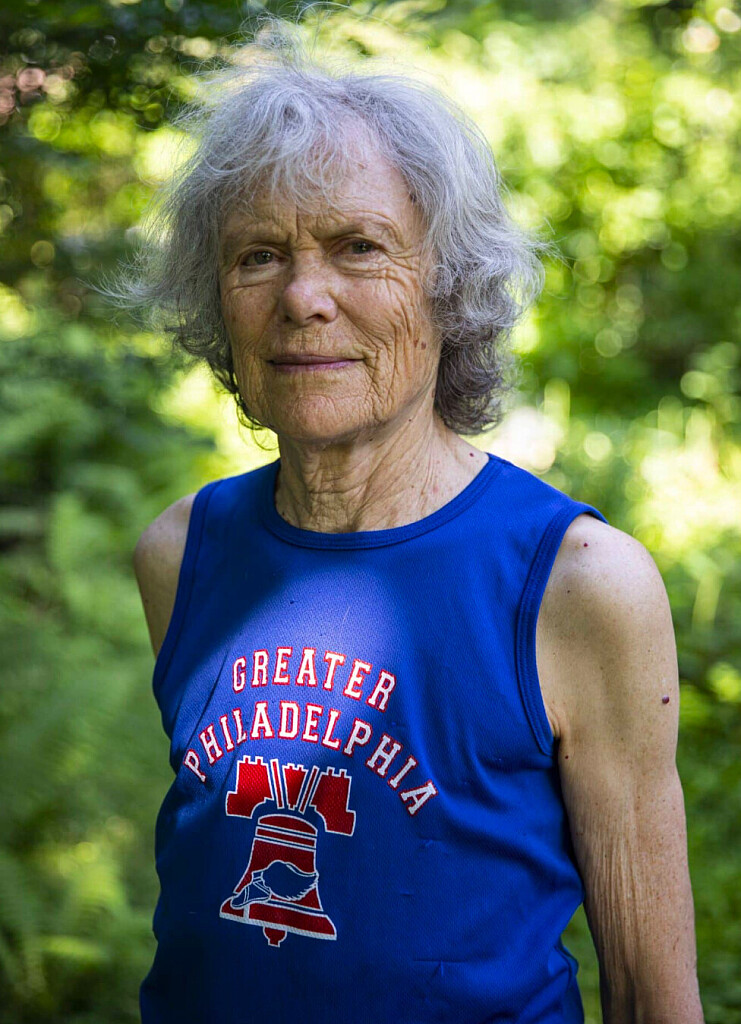Running News Daily
Running News Daily is edited by Bob Anderson. Send your news items to bob@mybestruns.com Advertising opportunities available. Train the Kenyan Way at KATA Kenya and Portugal owned and operated by Bob Anderson. Be sure to catch our movie A Long Run the movie KATA Running Camps and KATA Potato Farms - 31 now open in Kenya! https://kata.ke/
Index to Daily Posts · Sign Up For Updates · Run The World Feed
How Much Have Tracks and Shoes Improved 10,000m Times? A Look at Billy Mills’ 1964 Olympic Gold Compared to Today
When Billy Mills won the 10,000 meters at the 1964 Tokyo Olympics, he shocked the world. A relative unknown at the international level, Mills surged past world record holder Ron Clarke in the final stretch to win gold in 28:24.4, setting an Olympic record. It remains one of the most famous upsets in Olympic history.
At the 2024 Paris Olympics, Billy Mills sat in the stands, watching intently as the men's 10,000-meter final unfolded. Sixty years after his historic victory in Tokyo, he witnessed another American, Grant Fisher, battling for the podium.

With two laps to go, Fisher was perfectly positioned, matching strides with the East African elites, his long, efficient stride reminiscent of Mills' own finishing kick in 1964.
As the bell rang for the final lap, Fisher surged, momentarily moving into second. Mills, now 86, leaned forward, sensing history. But in the last 100 meters, Fisher was edged out, securing bronze. Mills smiled, knowing how close greatness had come again. Fisher clocked 26:43.46, just one third of a second behind the gold medal winner.
Mills had ran his time on a cinder track, wearing "basic running shoes"—conditions that would be considered primitive compared to today’s high-tech track surfaces and carbon-plated racing shoes. Given all the advancements in running technology, how much faster could Billy Mills have run on a modern track with today’s footwear? And how much have these innovations contributed to the faster times we see today?
The Difference Between Cinder and Synthetic Tracks
One of the biggest changes in distance running over the last six decades has been the transition from cinder tracks to synthetic surfaces. Cinder tracks, composed of crushed brick, coal, or ash, provided uneven footing, absorbed energy from each step, and became soft and unpredictable when wet. Athletes often wore spikes with long, heavy pins to grip the loose surface.

By contrast, modern synthetic tracks, introduced in the late 1960s, offer a firm, springy surface that returns more energy to the runner with each stride. Research suggests that switching from a cinder track to a synthetic track can improve distance-running performance by about 1-2 percent.
For a 10,000-meter race, a 1-2 percent time reduction equates to about 17 to 34 seconds. This means that if Billy Mills had run his race on a modern track, his time could have been anywhere between 27:50 and 28:07 just from the track surface alone.
The Impact of Modern Running Shoes
The second major advancement in distance running has been the development of carbon-plated racing shoes with high-energy-return foams. The latest models, introduced after 2016, are designed to reduce energy loss with each step, making it easier for runners to maintain their pace over long distances. Studies suggest these shoes provide 2-4 percent energy savings, which translates to a 30-60 second improvement over 10,000 meters.
Adding this to the estimated track advantage, Mills’ performance could have been further improved, bringing his potential time down to around 26:50 to 27:30.
Comparing Billy Mills’ Performance to Modern Champions
The current Olympic record for the 10,000 meters was set by Uganda’s Joshua Cheptegei at the 2024 Paris Olympics with a time of 26:43.14. That’s 1 minute and 41 seconds faster than Mills' winning time.
However, when we factor in advancements in track surfaces and footwear, the estimated modern equivalent of Mills’ race suggests he could have run within a minute of today’s best, making him far more competitive by modern standards than his official time suggests.
Other Factors That Have Led to Faster 10,000m Times
While tracks and shoes play a significant role in faster performances, several other factors have contributed to the improvement in 10,000-meter times over the decades:
More specialized training. Today’s distance runners have more scientifically tailored training programs, including altitude training, precise recovery strategies, and improved strength training techniques.
Better pacing and race strategy. Modern races are often assisted by pacemakers who set a steady, fast pace, helping runners conserve energy and stay consistent. In contrast, Mills’ race was a classic tactical battle with surges and slow-downs.
Nutritional and recovery advances. Today’s runners have access to optimized hydration, fueling, and recovery methods that allow them to train harder and more efficiently.
Billy Mills’ Performance in Context
Billy Mills’ gold medal run remains one of the most inspiring performances in Olympic history, not just because of the time he ran, but because of the way he won. His dramatic sprint finish against heavily favored competitors on a slower, less predictable surface showcased his incredible talent, toughness, and racing instincts.
Had he raced under today’s conditions with modern advantages, Mills likely would have been among the best in the world by today’s standards. His story is a reminder that while technology has helped athletes run faster, the heart and determination behind great performances remain unchanged.
The next time you watch an Olympic 10,000-meter race, consider just how much conditions have changed since 1964—and how incredible it was for Billy Mills to win on that cinder track with the tools available at the time. His legacy stands as a testament to the pure competitive spirit of running.
(02/12/2025) ⚡AMPby Boris Baron
Running Outside Your Comfort Zone: How to Push Your Limits and Achieve More
Running outside your comfort zone is about pushing past your usual limits, stepping into a place of discomfort, and embracing the challenge that leads to improvement. It’s the difference between running at a comfortable, familiar pace and pushing yourself to a point where your body and mind are tested.
For an elite athlete, this means running at world-class paces that demand peak physical and mental effort. For an average runner, it means running faster, longer, or with greater intensity than they are used to—whether that’s shaving seconds off a 5K time, running a new distance, or finishing a tough interval workout.
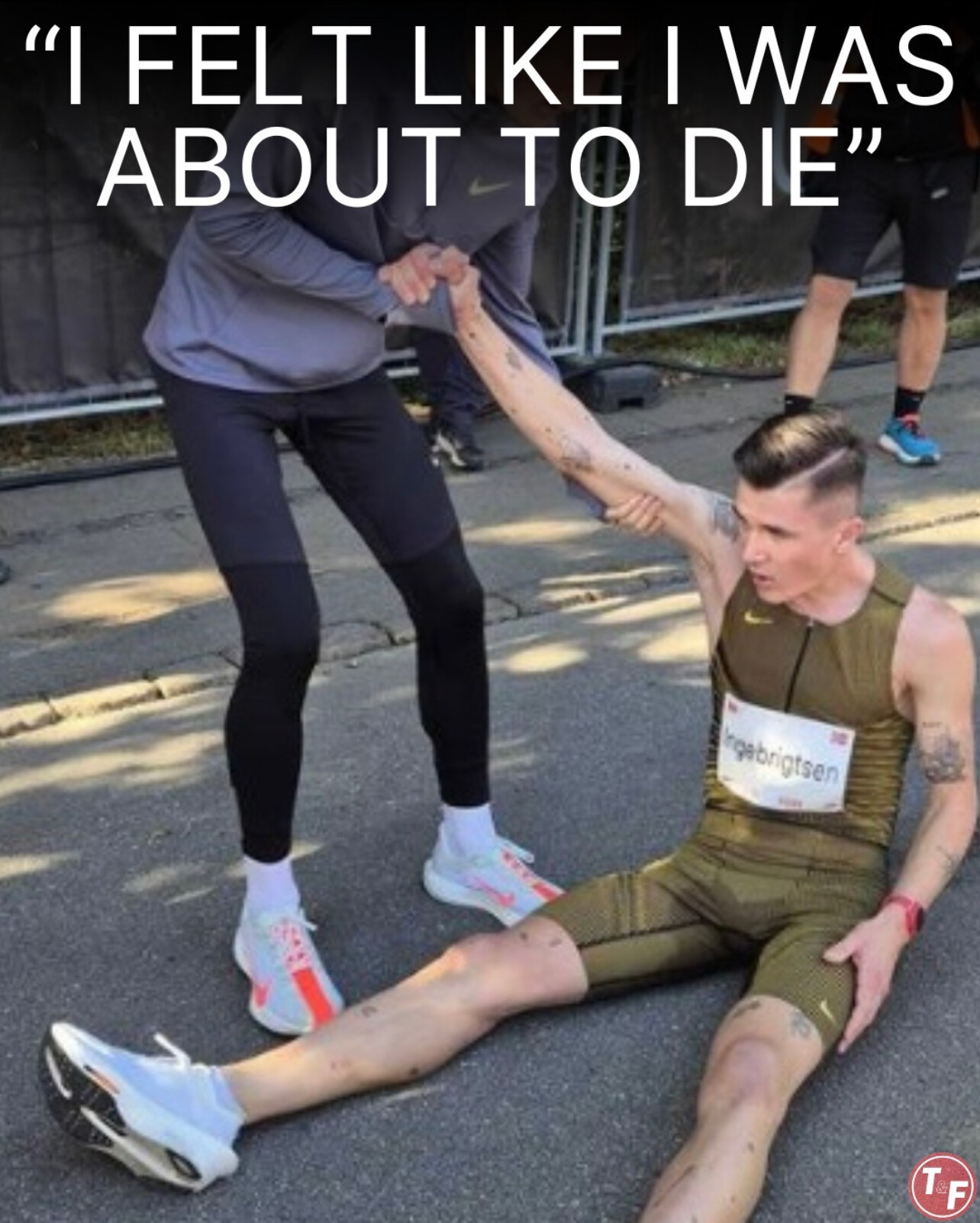
This powerful image captures Jakob Ingebrigtsen at the absolute limits of his endurance, a moment that epitomizes what it means to push beyond the comfort zone in elite racing. Ingebrigtsen, one of the most dominant middle-distance runners in the world, is seen completely spent, collapsed on the ground, relying on assistance just to get up. His quote, "I felt like I was about to die," is not just dramatic-it's a reflection of what it takes to compete at the highest level, where the margins between victory and defeat are razor-thin.
For elite athletes like Ingebrigtsen, racing is about embracing suffering rather than avoiding it. He has trained his body and mind to withstand extreme discomfort, knowing that to achieve greatness, he must run through the pain, not away from it. This image serves as a powerful reminder that whether you're an Olympic champion or an everyday runner chasing a personal best, the only way to truly improve is to push beyond what feels comfortable and into that space where breakthroughs happen.
The key to improving as a runner is learning how to handle discomfort without giving in to it. The body adapts when it’s challenged, but only if you consistently step beyond your comfort zone.
How the Average Runner Can Learn to Push Their Limits
Many runners stay at the same pace for years because they never challenge themselves beyond their current ability. Here’s how an average runner can start running outside their comfort zone.
Run at a Pace That Feels Uncomfortable
Most runners settle into a pace that feels sustainable and manageable. To break through plateaus, introduce faster running into your routine.
Progression runs: Start slow and gradually increase your pace so that the final third of the run is at a challenging but controlled effort.
Threshold runs: Run 10-15 minutes at a comfortably hard pace, where you’re breathing heavily but still in control.
Strides and surges: Add 20–30 second accelerations at the end of easy runs to build speed without fatigue.
Train with Purposeful Discomfort
Pushing beyond your limits doesn’t mean running recklessly—it means training your body to handle discomfort efficiently.
Intervals: Short, fast efforts (e.g., 6 x 400m at 5K pace) followed by short rest periods train your body to sustain effort even when tired.
Hill repeats: Running uphill improves strength and stamina, forcing you to push through discomfort.
Long runs with fast finishes: Ending long runs at a faster pace teaches your body to keep going when tired.

Improve Mental Toughness
Running outside your comfort zone isn’t just physical—it’s mental. When your legs get tired and your breathing gets heavy, your mind will tell you to slow down. Learning to override that voice is crucial.
Mantras: Repeating phrases like “strong and steady” or “I can do this” can help override negative thoughts.
Controlled discomfort: Remind yourself that pain in running isn’t the same as injury—it’s a sign of growth.
Visualization: Picture yourself finishing strong before your run starts. Your body follows what your mind believes.
Race More Often
The best way to step out of your comfort zone is to race regularly. In a race setting, you’re more likely to push yourself harder than you would in training. Even if you’re not at peak fitness, toeing the start line forces you to test your limits.
How Elite Athletes Push Their Limits at World-Class Pacing
When watching professional runners race, it’s easy to think they make it look effortless. The truth is, they are almost always on the edge of discomfort, running at a pace that would break most runners within minutes.
World-Class Pacing and the Pain Zone
Elite runners train to be comfortable with discomfort. Whether it’s a marathoner running under five-minute miles for 26.2 miles or a sprinter giving 100% effort for just 10 seconds, they are conditioned to hold their effort at a threshold most people can’t sustain.
Marathoners like Eliud Kipchoge spend years training their bodies to maintain high speeds without breaking down. His sub-2-hour marathon (averaging 4:34 per mile) was only possible because of relentless training outside his comfort zone.
Middle-distance runners like Jakob Ingebrigtsen in the 1500m race push through extreme fatigue in the final lap, training their bodies to hold off the competition while running at speeds most runners can’t even sprint.
Mental Fortitude at the Elite Level
At the world-class level, running outside the comfort zone is as much mental as it is physical. Elite runners:
Train to tolerate pain – They expect discomfort and use it as a signal to push harder, not slow down.
Use tactical thinking – Instead of panicking when they feel tired, they focus on form, breathing, and staying in the race mentally.
Embrace suffering – They view discomfort as part of the journey, knowing that real improvement only happens when they challenge their limits.
Gene Dykes and Rosa Mota: Masters of Pushing the Limits
Some of the best examples of runners stepping outside their comfort zones come from masters athletes.
At age 70, Gene Dykes ran a marathon in 2:54:23 at the Jacksonville Marathon. His ability to continue running world-class times at an age when most runners have slowed dramatically is a testament to smart training, mental fortitude, and a willingness to embrace discomfort.
Rosa Mota, the 1988 Olympic marathon champion, continues to redefine what’s possible for older runners. In December 2024, at age 66, she ran a 10K in 38:23 at the San Silvestre Vallecana, setting a new world record for the W65 category. Even decades after her Olympic victory, she remains a fierce competitor, proving that world-class pacing and a commitment to pushing limits don’t have an expiration date.
Why Running Outside Your Comfort Zone Matters
If you want to improve as a runner—whether you're chasing a faster 5K, your first marathon, or simply becoming stronger—you have to train beyond what feels easy.
Running outside your comfort zone doesn’t mean reckless overtraining, but it does mean challenging your limits in a controlled, smart way. Whether it’s picking up the pace, racing more often, or simply not backing down when things get tough, stepping beyond what feels comfortable is where real growth happens.
Elite athletes live in this zone during competition. The average runner can train to experience it too—and that’s how true breakthroughs happen.
(02/12/2025) ⚡AMPby Boris Baron
The Science of Longevity in Running: How Some Runners Stay Fast for Decades
Running is often thought of as a young person’s sport, but time and time again, we see athletes defying age, continuing to run and even race well into their 60s, 70s, and beyond. Some runners, like My Best Runs founder Bob Anderson, who started running in February 1962 and is still going strong today, prove that longevity in the sport isn’t just possible—it’s achievable with the right approach.
What allows some runners to maintain speed and endurance over the decades while others slow down? The answer lies in science, training adaptations, mindset, and lifestyle choices. This article explores how runners can stay competitive for life—and perhaps even improve with age.

The Science of Aging and Running Performance
Physiologically, runners experience certain changes as they age:
• VO2 max naturally declines at a rate of about 10% per decade after 40. However, regular training can slow this decline significantly.
• Muscle fibers shrink, and fast-twitch fibers deteriorate faster than slow-twitch fibers, impacting speed and power. Strength training and sprint workouts can help counteract this.
• Tendons lose elasticity, and cartilage wear increases, making injury prevention crucial.

• The body takes longer to recover from hard workouts, making rest, nutrition, and cross-training essential for long-term success.
The good news is that lifelong runners often have stronger hearts, denser bones, and slower biological aging than non-runners. Regular endurance training can reduce the risk of cardiovascular disease, osteoporosis, and cognitive decline.
Training Smart: Adapting Workouts for Longevity
Many runners burn out or get injured because they don’t adjust their training as they age. Here’s how to train smart for decades.
Maintain Speed with Strides and Intervals
Fast-twitch muscle fibers decline faster than slow-twitch fibers, but incorporating short sprints, strides, and intervals helps retain speed. Even just six to eight 100-meter strides at the end of easy runs can keep the neuromuscular system sharp.
Prioritize Strength Training
Strength training two to three times per week can help counteract muscle loss, improve bone density, and prevent injuries. Key exercises include squats, lunges, core work, and hip mobility drills.
Adjust Recovery
Younger runners recover quickly, but for those over 50, rest and active recovery days become more important. Running every day might not be sustainable, but alternating hard workouts with cross-training, such as cycling, swimming, or hiking, can help maintain fitness without overuse injuries.
Keep Mileage Consistent
Aging runners who maintain a consistent but moderate mileage base tend to perform better long-term than those who dramatically reduce or increase mileage. The key is staying active year-round and avoiding long breaks that lead to muscle loss and decreased aerobic capacity.
Nutrition and Recovery: Fueling for the Long Run
Proper nutrition plays a major role in running longevity.
Focus on Anti-Inflammatory Foods
Chronic inflammation contributes to aging and joint pain. Long-term runners benefit from foods rich in omega-3s (salmon, walnuts), antioxidants (berries, leafy greens), and lean proteins (chicken, beans).
Stay Hydrated and Maintain Electrolyte Balance
As we age, our sense of thirst declines, so staying hydrated becomes more critical. Older runners are also more prone to electrolyte imbalances, making magnesium, sodium, and potassium intake vital.
Increase Protein Intake
After 50, the body needs more protein to maintain muscle mass. Aim for 1.2–1.6 grams of protein per kilogram of body weight daily, focusing on high-quality sources like eggs, lean meats, Greek yogurt, and plant-based proteins.
Mental Toughness and Staying Motivated
Longevity in running isn’t just about the body—it’s also about the mind. Many lifelong runners stay motivated by setting new goals, training with a group, and embracing the aging process rather than resisting it.
Bob Anderson, founder of My Best Runs, started running in February 1962 and continues to train and race today. His ability to sustain a high level of performance comes down to consistent training, smart adaptations, and a passion for the sport. His 6:59 per mile pace for 350 miles of racing (50 races totally 350.8 miles over one year) at age 64 is proof that age is just a number when you train right. More recently he ran 49:48 for 10k at age 76.
The Role of Cross-Training and Injury Prevention
Even the most dedicated runners face injuries. The key to longevity is knowing when to rest and when to cross-train.
Some of the best cross-training options for runners over 50 include cycling, swimming, pickleball, hiking, and yoga. Incorporating at least one non-running workout per week reduces injury risk and keeps running sustainable for the long haul.
Gene Dykes and Rosa Mota: Icons of Running Longevity
Bob Anderson is not alone in proving that age is just a number. Gene Dykes, one of the most remarkable masters runners in history, has shattered records in his 70s. At age 70, he famously ran a 2:54:23 marathon.
His secret? A high-mileage approach combined with interval training and a love for the sport that keeps him motivated year after year.
On the women's side, Rosa Mota, the legendary Portuguese marathoner and 1988 Olympic gold medalist, continues to inspire runners worldwide. Even in her 60s, she remains an active ambassador for the sport, showing that passion, consistency, and smart training allow runners to stay competitive for life.
In December 2024, at age 66, Rosa Mota set a new W65 10K world record by completing the San Silvestre Vallecana race in 38:23.
Both Dykes and Mota exemplify the idea that the body can continue to perform at a high level if treated right. Their stories, along with those of runners like Bob Anderson, prove that longevity in running is not just about genetics-it's about persistence, training adaptations, and maintaining the joy of ring.
Final Thoughts: Running for Life
Longevity in running isn’t about fighting age—it’s about embracing the journey, adapting intelligently, and staying passionate. The best runners understand that while paces may slow, the love of the sport grows deeper with time.
Whether you’ve been running since February 1962 like Bob Anderson or are just starting in your 50s or 60s, consistency, smart training, and joy in the process are the real secrets to running for life.
(02/12/2025) ⚡AMPby Boras Baron
Fast Times and Personal Bests Highlight February KATA Time Trial
It was a beautiful day at the Kenya Athletics Training Academy (KATA) in Thika as athletes lined up for the monthly February edition of the KATA Time Trial. With 31 registered participants, the event showcased remarkable performances, personal bests, and promising young talents.
In the men’s 10K, Peter Mwaniki (second photo) dominated the race, crossing the finish line in an impressive 28:59. He was followed closely by Peter Mburu in 29:27, with Raphael Karita securing third place in 29:28. However, the standout performance of the day belonged to Stephen Ngigi, who finished fourth with a personal best of 29:30. Ngigi’s dedication to improvement has been evident, shaving off more than 30 seconds from his previous mark and lowering his personal best by over 70 seconds in just three months.
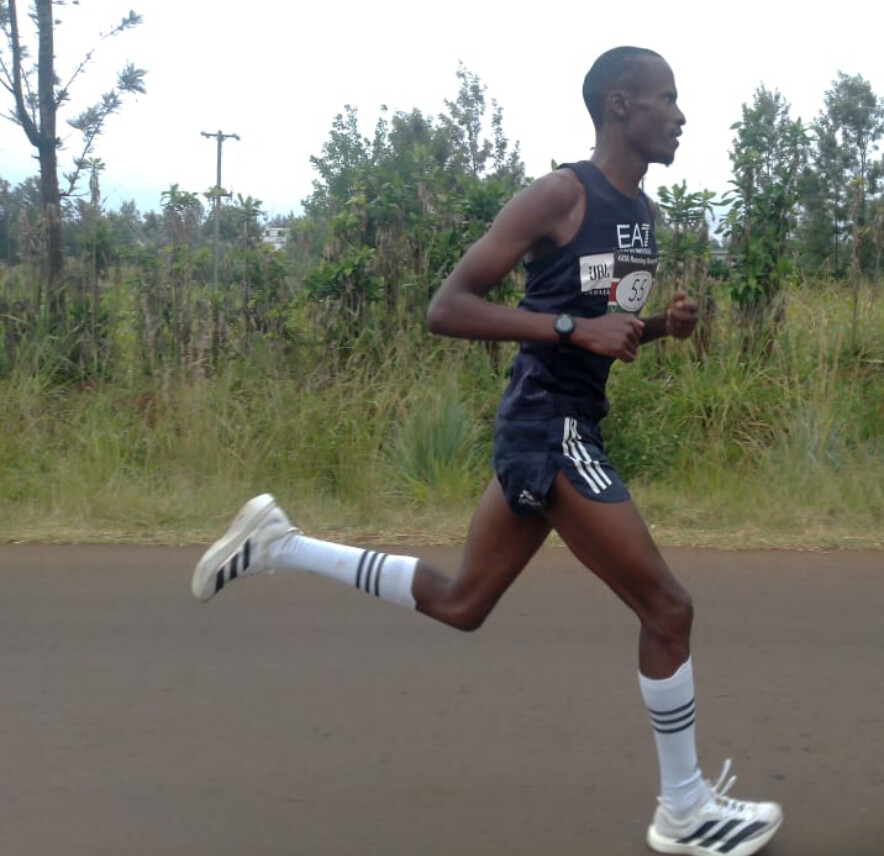
On the women’s side, Kellen Waithira took the 10K crown, stopping the clock at a stellar 34:56. She was followed by Lois Karie, who finished strong in 35:31.
The junior athletes also put on a show, with Justus Nyamai, 17 years old, posting 16:13 and Peter Waititu, also 17, finishing in 16:58 in their respective events. Their efforts signal a bright future for Kenyan distance running.

KATA’s women sprinters stepped up for the 5K race, showing their versatility. Kenya’s 100m icon, Doreen Waka, finished second, using the race as preparation for her first track meeting of 2025, set to take place in just two days.
The February time trial at KATA once again proved to be a stage for elite performances, breakthrough moments, and the emergence of new talent. With dedication and hard work, these athletes continue to push the boundaries, making KATA a hub for world-class distance running.
Official Results
10km MEN
1. Peter Mwaniki, 27, Bib 55 – 28:59
2. Peter Mburu, 26, Bib 27 – 29:27
3. Raphael Karita, 24, Bib 26 – 29:28
4. Stephen Ngigi, 20, Bib 1 – 29:30
5. John Kuria, 30, Bib 43 – 30:07
6. James Maina, 27, Bib 2 – 30:27
7. John Chege, 19, Bib 7 – 30:38
8. Boniface Mungai, 29, Bib 14 – 31:54
9. Julius Mwangi, 41, Bib 34 – 32:57
10. Charles Ndirangu, 24, Bib 4 – 33:33
11. Ali Rashid, 22, Bib 3 – 34:50
12. David Muriuki, 39, Bib 23 – 34:57
13. Charles Ndirangu, 64, Bib 40 – 38:13
10km WOMEN
1. Kellen Waithira, 37, Bib 44 – 34:56
2. Lois Karie, 24, Bib 42 – 35:31
3. Pauline Wanjiku, 17, Bib 49 – 35:55
4. Karen Chepkemoi, 23, Bib 223 – 36:09
5. Susan Njuu, 37, Bib 48 – 36:23
6. Naomi Wambui, 40, Bib 53 – 37:15
7. Everlyn Wanjiku, 27, Bib 29 – 39:18
8. Lucy Muritu, 39, Bib 47 – 46:05
5km MEN
1. Kariuki Wangari, 25, Bib 22 – 16:05
2. Ismael Mburu, 23, Bib 13 – 16:07
3. Frederick Wambua, 20, Bib 66 – 16:11
4. Justus Nyamai, 17, Bib 39 – 16:13
5. Peter Waititu, 17, Bib 46 – 16:58
5km WOMEN
1. Pauline Muhavi, 22, Bib 50 – 19:00
2. Doreen Waka, 29, Bib 63 – 23:36
3. Sheila Makungu, 21, Bib 51 – 23:39
4. Peris Chege, 36, Bib 52 – 24:47
5. Teresa Wangui, 23, Bib 20 – 24:51
The 43rd KATA Time Trial will be held on March 12. All runners of all abilities are invited to join us. For more info, contact our KATA manager, Chris.
(02/12/2025) ⚡AMPby Coach John
KATA Time Trial Series
Welcome to the KATA Monthly Time Trial Held at the Kenyan Athletics Training Academy in Thika, Kenya, the KATA Monthly Time Trial is a unique and inclusive event designed to support runners of all levels in achieving their goals and showcasing their fitness. This event offers both 10K and 5K distances on an accurate, certified course, providing participants with...
more...How Training High and Racing Low Can Give You an Edge
For serious runners looking to optimize their training, altitude can be a game-changer. The widely recognized "Live High, Train Low" (LHTL) approach—spending time at moderate altitude before returning to sea level—has been used by elite athletes for decades to gain a competitive edge. But how exactly does it work, and how can you incorporate it into your own training?
Why Train at Altitude?

At elevations of around 5,000–7,000 feet, the air contains less oxygen, forcing the body to adapt by producing more red blood cells. This increases the blood’s oxygen-carrying capacity, leading to:
Enhanced endurance due to improved oxygen efficiency
Greater aerobic strength from increased EPO production
Stronger lung function as the body adapts to lower oxygen levels
This is why many world-class runners train in places like KATA Kenya (5,400 feet), where the natural altitude boosts their aerobic capacity.
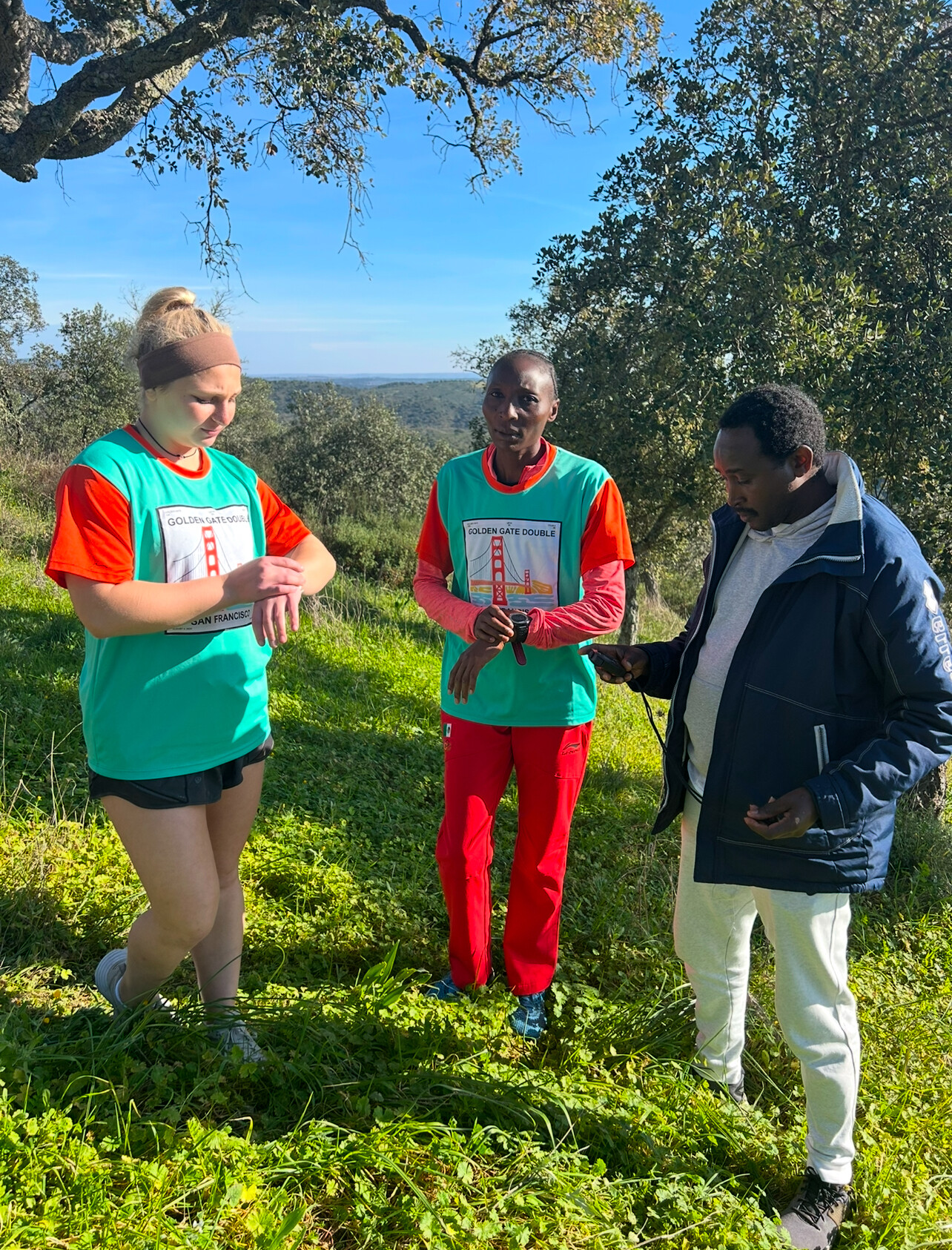
Why Return to Sea Level Before Racing?
While altitude training enhances oxygen efficiency, it limits the ability to train at full intensity due to reduced oxygen availability. That’s where the second half of the strategy—training at sea level—comes in. Returning to lower altitudes, like KATA Portugal (300 feet), allows runners to:
Train at higher intensities with greater oxygen availability
Improve speed and power output
Benefit from faster recovery before race day
Studies suggest that returning to sea level 2-3 weeks before a race is ideal for maximizing performance. This timing allows runners to fully absorb the benefits of altitude training while taking advantage of enhanced oxygen levels to fine-tune race pace.
How to Incorporate Altitude Training into Your Plan
If you can train at altitude for 3-6 weeks before returning to sea level, you can gain significant endurance advantages without sacrificing race-day speed. Even if you don't have access to an altitude camp, strategies like sleeping in an altitude tent or using intermittent hypoxic training can simulate some of the effects.
For those serious about optimizing performance, finding the right balance between altitude and sea-level training—just like what’s possible at KATA Kenya and KATA Portugal—could be the key to your next PR.
(02/11/2025) ⚡AMPby Boris Baron
Rest in Peace, Jerome Drayton: Canadian Marathon Legend Passes Away at 80
The world of distance running has lost one of its greats. Jerome Drayton, the Canadian marathon record holder for over 40 years, passed away early today at the age of 80. A true pioneer in Canadian distance running, Drayton inspired generations of athletes with his remarkable performances on the international stage.
Born in Germany before immigrating to Canada, Drayton became one of the most dominant marathoners of his era. He competed in the 1968 Olympic Games in Mexico City and the 1976 Olympic Games in Montreal, proudly representing Canada. His most famous victory came at the 1977 Boston Marathon, where he became the first Canadian winner in 34 years. Drayton was also a three-time champion of the prestigious Fukuoka Marathon in Japan, one of the world’s most competitive races at the time.

Drayton’s Canadian marathon record of 2:10:09, set in 1975 at Fukuoka, remained untouched for an astonishing 43 years until it was finally broken in 2018. His dominance and consistency made him one of the most respected marathoners globally. He competed for the Toronto Olympic Club under the guidance of coach Paul Poce, a National Team Coach who helped shape many of Canada’s top distance runners.

Beyond his achievements, Drayton was admired for his humility and sportsmanship. Those who had the chance to meet him, including at club banquets, remember him as an inspiring presence and a true gentleman.
His contributions to Canadian distance running will never be forgotten. Jerome Drayton showed Canadian runners what was possible, and his legacy will continue to inspire future generations.
Rest in peace, Jerome, and thank you for everything you gave to the sport.
(02/11/2025) ⚡AMPby Boris Baron
Caitlyn Jenner Supports Trump’s Executive Order Banning Transgender Athletes in Women’s Sports
On February 5, 2025, President Donald Trump signed an executive order titled “Keeping Men Out of Women’s Sports,” which prohibits transgender women from participating in female sports categories. The order directs federal agencies, including the Department of Justice, to interpret Title IX rules as excluding transgender girls and women from female sports teams. Schools that allow transgender women to compete in women’s sports now risk losing federal funding.
During the announcement, Trump stated, “We will defend the proud tradition of female athletes. From now on, women’s sports will be only for women. The war on women’s sports is over.”

Caitlyn Jenner’s Response
Caitlyn Jenner, a transgender woman and former Olympic decathlete, publicly supported the executive order, saying:

"Another victory in the fight for protecting women’s sports! President Trump signs an Executive Order keeping biological men out of women’s sports! As an Olympian, I will continue to fight this issue, lobbying sport governing bodies all over the world to follow our lead!”
Jenner’s stance has sparked controversy, with many of her X (formerly Twitter) followers expressing confusion and criticism. Some argue that her position contradicts her advocacy for transgender rights, while others praise her for prioritizing competitive fairness in women’s sports.
Background: Caitlyn Jenner’s Athletic Legacy
Before her transition, Caitlyn Jenner was known as Bruce Jenner, one of the greatest athletes of the 20th century. Jenner won the gold medal in the decathlon at the 1976 Montreal Olympic Games, setting a world record with 8,618 points. This achievement earned her the title of “world’s greatest athlete.”
In 2015, Jenner publicly came out as transgender and announced her transition, becoming one of the most high-profile transgender figures in the world. She has since been an active voice in debates surrounding transgender rights, politics, and sports policies.
The Ongoing Debate
Jenner’s support for Trump’s executive order reflects her long-held stance on maintaining competitive fairness in women’s sports. However, this issue remains divisive, with both supporters and critics debating whether such policies promote fairness or discrimination.
As sports governing bodies and policymakers continue to grapple with transgender inclusion in athletics, Caitlyn Jenner’s influence in shaping the conversation remains significant. Her latest statement reaffirms her belief that sports competition should be separated by biological sex, a viewpoint that continues to generate widespread discussion.
(02/10/2025) ⚡AMPYalemzerf Yehualaw and Bernard Koech Dominate the 2025 Dubai Half Marathon
The 2025 Dubai Half Marathon, held on February 9, delivered another thrilling edition of one of the world’s fastest and most competitive half marathons. With a deep field of elite runners, Yalemzerf Yehualaw of Ethiopia and Bernard Kiprop Koech of Kenya emerged victorious in the women’s and men’s races, respectively.
Men’s Race: Bernard Koech Secures Victory in Fast-Paced Battle

In the men’s race, Kenya’s Bernard Kiprop Koech claimed victory with a stellar time of 1:00:15, showcasing his strength in the final kilometers. He was closely followed by fellow Kenyan Wisley Kipkemoi, who crossed the line in 1:00:38, securing second place. Completing the Kenyan-dominated podium was Enos Kipruto, finishing in 1:01:40.
The men’s race started at a blistering pace, with an early pack of contenders pushing the limits through the flat and fast streets of Dubai. The decisive move came in the last five kilometers, where Koech displayed a strong surge to break away from Kipkemoi and secure the win.
Women’s Race: Yalemzerf Yehualaw Reigns Supreme
On the women’s side, Ethiopia’s Yalemzerf Yehualaw showcased her dominance in the half marathon distance, clinching victory in 1:07:09. The 25-year-old long-distance star, known for her impressive endurance and closing speed, maintained a controlled pace throughout before making her move in the latter stages of the race.
Behind Yehualaw, Great Britain’s Eilish McColgan finished in 1:08:58, securing second place with a strong performance. Kenya’s Jackline Cherono rounded out the podium with a time of 1:09:33.
Yehualaw’s win in Dubai adds to her growing legacy in road racing, reaffirming her place as one of the best half marathon specialists in the world.
A World-Class Event in Dubai
The Dubai Half Marathon, previously known as the Burj2Burj Half Marathon, has quickly established itself as a premier event in the global running calendar. The race takes runners through a scenic yet challenging course in one of the world’s most vibrant cities, attracting some of the biggest names in distance running.
Despite warm temperatures and moderate winds, the 2025 edition saw fast times and tactical racing, keeping spectators on the edge of their seats. The event continues to be a favorite for both elite runners and amateur athletes, thanks to its world-class organization and fast course.
As the road racing season progresses, eyes will be on Yalemzerf Yehualaw and Bernard Koech to see how they build on their Dubai victories in upcoming races.
Final Results – 2025 Dubai Half Marathon
Men’s Race
1. Bernard Koech (Kenya) – 1:00:15
2. Wisley Kipkemoi (Kenya) – 1:00:38
3. Enos Kipruto (Kenya) – 1:01:40
Women’s Race
1. Yalemzerf Yehualaw (Ethiopia) – 1:07:09
2. Eilish McColgan (Great Britain) – 1:08:58
3. Jackline Cherono (Kenya) – 1:09:33
(02/10/2025) ⚡AMPby Boris Baron
Camille Herron and the Wikipedia Controversy: Integrity in Ultrarunning Under Scrutiny
Update: after reading our article Camille sent this to MBR "Individuals are violating World Athletic rules and publicly claiming they broke my records. It’s undermining the integrity of the sport and devaluing those who adhere to the rules and the ratified record holders, including me.
I hope Yiannis’s statement provides added clarity who’s behind the push to disregard the rules and retaliated against me."
Camille Herron recently addressed the Wikipedia controversy on her Facebook page, expressing her commitment to fairness and accountability in ultrarunning. She acknowledged the challenges of speaking up about rules and technicalities, noting that it can lead to retaliation.

Herron emphasized that the International Association of Ultrarunners (IAU) has validated her concerns twice, confirming that she continues to hold the IAU World Records and World Bests for 48 Hours and 6 Days. She concluded by thanking her supporters and reaffirming her dedication to integrity in the sport.
In September 2024, the ultrarunning community was shaken by a controversy involving American ultrarunner Camille Herron and her husband and coach, Conor Holt. The couple was accused of editing Wikipedia pages to enhance Herron's achievements while diminishing those of her competitors.

An investigation by Canadian Running revealed that two Wikipedia accounts, "Temporun73" and "Rundbowie," were linked to Herron's email and Holt's IP address. These accounts made numerous edits to Herron's page, amplifying her accomplishments, and altered the pages of fellow ultrarunners, including Courtney Dauwalter and Kilian Jornet, to downplay their achievements. For instance, statements like "widely regarded as one of the best trail runners ever" were removed from competitors' pages, while Herron was described as "widely regarded as one of the greatest ultramarathon runners of all time."
Following the exposure of these activities, Herron's primary sponsor, Lululemon, terminated their partnership with her. In a statement, the company emphasized its commitment to equitable competition and stated, "After careful consideration and conversation, we have decided to end our ambassador partnership with Camille."
In response to the allegations, Holt took full responsibility, stating, "Camille had nothing to do with this. I'm 100 percent responsible and apologize [to] any athletes affected by this and the wrong I did." He explained that his actions were an attempt to protect Herron from online harassment and bullying that had adversely affected her mental health.
The incident has sparked widespread discussion within the ultrarunning community, with many expressing disappointment over the unsportsmanlike behavior. Herron, known for her numerous world records and contributions to the sport, now faces challenges in rebuilding trust and credibility within the community.
As the situation unfolds, it serves as a reminder of the importance of integrity and sportsmanship in athletics. The ultrarunning community continues to reflect on the implications of this controversy and the lessons to be learned moving forward.
(02/10/2025) ⚡AMPby Boris Baron
The Science Behind Negative Splits
In the world of distance running, pacing is paramount. One strategy that has garnered attention for its effectiveness is the negative split—running the second half of a race faster than the first. This approach not only conserves energy but also positions runners to finish strong, often leading to personal bests.
Starting a race conservatively allows the body to warm up thoroughly, optimizing muscle efficiency and oxygen utilization. As the race progresses, a well-timed increase in pace can capitalize on this preparedness. Physiologically, this method helps in managing glycogen stores and delaying the onset of fatigue, enabling a stronger finish.

Training Techniques to Master Negative Splits
Progression Runs: Begin at a comfortable pace and gradually increase speed throughout the run. For instance, on a 10-mile run, start at a relaxed pace for the first 5 miles, then incrementally quicken your pace in the latter half.
Tempo Runs with a Fast Finish: Maintain a steady tempo pace for a set distance, then accelerate in the final segment. This trains the body to handle increased effort when fatigued.
Interval Training: Incorporate intervals that encourage finishing faster. For example, run 800-meter repeats where the second 400 meters is faster than the first. This not only builds speed but also instills the discipline to negative split.

Controlled Long Runs: During long runs, practice starting slower than your target race pace and finishing the last few miles faster. This simulates the fatigue of a race and conditions the mind and body to push through.
Elite Runners Embracing Negative Splits
Many elite runners have successfully employed negative splits in their racing strategies:
Eliud Kipchoge: During the 2016 Olympic Marathon, Kipchoge ran the first half in 1:05:55 and the second half in 1:02:49, securing the gold medal with a significant negative split.
Kelvin Kiptum: In the 2023 Chicago Marathon, Kiptum set a new world record by running the first half in 60:48 and the second half in 59:47, showcasing a remarkable negative split.
Kenenisa Bekele: In his 5000-meter world-record run, Bekele progressively increased his speed, running each kilometer faster than the previous one, exemplifying the negative split strategy.
Implementing Negative Splits in Your Racing Strategy
To effectively incorporate negative splits into your racing:
Start Conservatively: Begin slightly slower than your goal pace to conserve energy.
Mid-Race Assessment: Regularly check in with your body and adjust your pace as needed, ensuring you have the energy to increase speed in the latter stages.
Strong Finish: Aim to progressively quicken your pace in the final miles, capitalizing on your conserved energy.
By mastering the art of negative splits, runners can race smarter, harnessing their energy efficiently to achieve stronger finishes and personal bests.
(02/10/2025) ⚡AMPby Boris Baron
Risper Gesabwa Shines at 10K Ibiza While Training at KATA Portugal at Anderson Manor
For the past five weeks, elite Kenyan/Mexican runner Risper Gesabwa has been training at KATA Portugal, based at Anderson Manor in Monforte da Beira. Using the retreat as her European training base, Gesabwa has been fine-tuning her speed and endurance while competing in races across Spain. On February 9, 2025, she delivered a strong performance at the 10K Ibiza, placing second with a time of 32:44.
KATA Portugal, an extension of the Kenyan Athletics Training Academy (KATA), has provided Gesabwa with an ideal environment to sharpen her fitness. The retreat, located in the peaceful Portuguese countryside, offers top-tier training facilities, structured sessions, and a supportive atmosphere that mirrors the disciplined approach of Kenyan training camps.

Her performance at the 10K Ibiza demonstrated her current form as she pushed the pace against a strong field. Running a 32:44 10K, she showcased her endurance and strength, reinforcing her reputation as a tough competitor. This performance is just the beginning, as she continues her racing season.
Following her successful European campaign, Gesabwa is returning to Mexico, where she resides, to prepare for upcoming competitions, including the highly anticipated Half Marathon Trials for the World Championships. With her current form and the strong foundation built at KATA Portugal, she is well-positioned to compete for a spot on the world stage.
Since arriving at Anderson Manor, Gesabwa embraced the structured training, cross-training options, and serene recovery environment. The retreat has proven to be a strategic base for athletes of all abilities looking to compete in Europe while maintaining the discipline and rigor of high-performance training.

Her next goal is to continue improving and securing top finishes in upcoming races. With KATA Portugal at Anderson Manor providing the perfect blend of intensive training, rest, and recovery, Gesabwa is in prime position to achieve even greater success on the road racing circuit.
As she prepares for her next competition, her time at KATA Portugal underscores the growing reputation of Anderson Manor as a premier training destination for athletes looking to make an impact on the international stage or just to improve their besty times.
(02/10/2025) ⚡AMPby Bob Anderson
10K Ibiza-Platja d'en Bossa
The 10K Ibiza-Platja d'en Bossa is an international road race renowned for its flat and fast course, making it one of the most attractive circuits in Spain. The event has received the prestigious World Athletics Label, underscoring its significance in the global running community. The race route offers participants a scenic experience, bordering the Ses Salines Natural Park and passing...
more...Teen Phenom Sam Ruthe Shatters Age-Group 1500m Record at Sir Graeme Douglas International
New Zealand's rising middle-distance star, Sam Ruthe, has added yet another milestone to his stunning season, breaking a world best for 1500 meters previously held by two-time Olympic champion Jakob Ingebrigtsen of Norway.
Competing at the Sir Graeme Douglas International in Auckland on February 9, 2025, the 15-year-old sensation clocked an incredible 3:41.25, finishing second behind Japan’s Ryoji Tatezawa (3:40.20). Along the way, Ruthe obliterated New Zealand's U17 and U18 records in yet another remarkable display of his talent.

His latest feat continues a historic two-week streak that has seen him produce jaw-dropping times across multiple distances:
4:01.72 for the mile
1:50.57 for 800m

7:56.18 for 3000m
Ruthe also recently became the youngest athlete to ever win a senior men’s national title in New Zealand.
While thrilled with his performance, Ruthe admitted that surpassing Ingebrigtsen’s age-group mark wasn’t his primary focus going into the race.
"I wasn't exactly targeting that record," he said. "I just went into the race hoping to do the best I could in terms of placing, and it was a bonus to get his record. I definitely had it in the back of my mind."
His time shaved over five seconds off his previous best, set en route to his mile record two weeks ago in Whanganui.
As in his 3000m national title race a week earlier, Ruthe executed a patient and tactical race, staying with the lead pack while others faded. Entering the final 100 meters in fourth, he unleashed a devastating kick, overtaking Australians Will Lewis and Matt Hussey to secure second place.
"I was actually quite lucky they both moved out quite wide, so I could find the gap," Ruthe explained. "It felt real, real nice having that gap open up. I go into these races, parking in behind the other people and hoping they pull me through—and this race did exactly that."
With every performance, Ruthe inches closer to an even bigger goal—becoming the youngest athlete to break four minutes for the mile, a feat also accomplished by Ingebrigtsen at 16 years old. His latest 1500m time suggests he’s within striking distance.
His next opportunity to chase history? The Maurie Plant Meet in Melbourne next month, where his performance in Auckland should secure him a spot in the elite mile field.
Ruthe's 3:41.25 brings him agonizingly close to another milestone—his father’s best time. Former New Zealand 1500m champion Ben Ruthe still holds the household record by just three-hundredths of a second.
"That's alright," the younger Ruthe said with a grin. "I don't think he'll have it for long, so he should enjoy it while it lasts."
With his meteoric rise, it’s only a matter of time before Sam Ruthe rewrites not just family records—but history itself.
(02/10/2025) ⚡AMPby Boris Baron
2025 Gate River Run Elite Battle for USA 15K Glory
The 2025 Gate River Run in Jacksonville, Florida, set for March 1, is not only America’s largest 15K but also serves as the USA 15K Championship—a high-stakes battleground where elite athletes from across the nation and around the globe will clash for glory, record-breaking prizes, and the opportunity to inscribe their names in running history.
This year’s event has rejoined the prestigious Professional Road Running Organization (PRRO) Circuit for the first time since 1993, significantly elevating its status with over $400,000 in total prize money at stake. Competitors face a guaranteed purse of $57,000 with additional bonuses that can boost the total to $62,000, and winners also earn eligibility for a $20,000 PRRO Super Bonus at the season-ending PRRO Championship in Utica, New York.

The prize structure is designed to reward outstanding performance and national pride. In the Open Division, the top 10 finishers in both the men’s and women’s fields will earn significant payouts, while U.S. athletes have the opportunity to “double dip” by competing for additional American Cup bonuses, which reward the top five finishers with extra cash ranging from $3,000 to $500. Adding an intriguing twist, the Equalizer Bonus awards the first athlete to cross the finish line—regardless of gender—an extra $5,000, and record-breaking performances are further incentivized with $10,000 for a world record, $5,000 for an American record, and $3,000 for a course record.

The 15K course itself is a true test of strategy and endurance as it weaves through Jacksonville’s urban landscape and culminates at the base of the Hart Bridge, famously nicknamed the “Green Monster” due to its steep, punishing incline. This final stretch demands that athletes balance blistering speed with tactical acumen as they fight to maintain their momentum and push through fatigue, echoing the challenges faced by past legends who set formidable benchmarks on this course. Organizers have gone to great lengths to support peak performance, providing elite athletes with complimentary airport transfers and accommodations at the Marriott Jacksonville Downtown, along with strict adherence to USATF and IAAF anti-doping policies. Qualification standards are stringent, with men required to finish under 46:00 and women under 53:00 to be eligible for prize money, ensuring that only the very best contend.
Adding to the excitement is the confirmed participation of marquee athlete Jacob Kiplimo, the current 15K world record holder known for his blistering 40:42 performance. Kiplimo’s entry, along with a strong contingent of top U.S. runners and promising international stars already confirmed, underscores the elite quality of the field this year. While the full elite roster is still being finalized, insiders report that several of America’s best middle- and long-distance runners are set to join the competition, with additional names expected to be announced in the coming weeks.
Beyond the elite competition, the Gate River Run remains a celebration of running culture, drawing over 18,000 participants—from dedicated runners to enthusiastic walkers—who join in the festivities and contribute to the event’s storied legacy. For professional athletes, however, this race is a career-defining opportunity; it is where every second matters, every stride is measured, and personal bests and record-breaking performances are the norm rather than the exception.
As the countdown to March 1 continues, anticipation builds among athletes and fans alike. The 2025 Gate River Run promises to be an arena where national pride meets global ambition, a platform for elite runners to test their limits and secure life-changing prizes while setting the stage for the upcoming outdoor season. For registration details, elite entry requirements, and live coverage, visit the official Gate River Run website or follow updates on My Best Runs.
(02/09/2025) ⚡AMPby Boris Baron
Gate River Run
The Gate River Run (GRR) was first held in 1978, formerly known as the Jacksonville River Run, is an annual 15-kilometer road running event in Jacksonville, Fla., that attracts both competitive and recreational runners -- in huge numbers! One of the great running events in America, it has been the US National 15K Championship since 1994, and in 2007...
more...No-Finish-Line Runs: The Emerging Trend of 'Open-Ended' Races and Personal Challenges
In a world increasingly focused on measurable outcomes and rigid milestones, a new wave of athletic events is redefining success by removing the finish line altogether.
These no-finish-line runs prioritize endurance, personal growth, and community over competition, with participants embracing the journey rather than chasing a fixed endpoint. At the heart of this movement lies the loop or repetitive course—a format that embodies the philosophy of endless possibility. Here’s how this concept is reshaping the future of running.

1. Loop or Repetitive Course: Redefining the Race Experience
The loop course model transforms traditional races into open-ended challenges. Instead of a linear route with a predetermined distance, runners navigate a repeated circuit—often 1 km or shorter—for as long as they choose. This structure democratizes participation, allowing athletes of all levels to set personal goals, whether completing 5 laps or 50.
Example: The No Finish Line Nice Charity Race
One standout event is the No Finish Line Nice, a 5-day charity race held annually on France’s Côte d’Azur. From May 14–18, 2025, participants will run or walk a 1 km loop along the Quai des Etats-Unis, with every kilometer translating to €1 donated to underprivileged and sick children. The course is open 24/7, encouraging runners to push their limits while fostering a collective effort toward a shared goal. Key features include:

Flexibility - Participants join solo or in teams, with no time constraints.
Inclusivity - Open to all ages, fitness levels, and even pets or strollers.
Community Impact - Funds raised directly support local causes, blending athleticism with altruism.
This model mirrors the ethos of Nike’s No Finish Line book, which argues that innovation and progress are not end points but endless journeys driven by creativity and collaboration .
2. Philosophy: The Intersection of Sport and Endless Potential
The loop course trend aligns with broader cultural shifts toward mindfulness and sustainability. By removing the pressure to “finish,” runners focus on incremental progress—a concept echoed in Nike’s vision for design and sport. As Nike Chief Design Officer John Hoke writes:
When we say ‘There is no finish line,’ it’s not about an unending grind, but a belief in the limitless potential of sport and design.
This philosophy rejects rigid definitions of success, inviting participants to embrace their unique paths. Similarly, Sam Grawe’s essays in *No Finish Line* predict a future where design evolves from “static to sensorial” and “elite to everyone”—principles that resonate with the democratized nature of loop races.
3. Why Loop Courses Are Gaining Momentum
Personalization - Athletes set their own benchmarks, whether running for 30 minutes or 5 days.
Sustainability - Compact courses minimize environmental impact compared to large-scale marathons.
Community Building - Shared spaces like the Nice waterfront create a festival-like atmosphere, blending sport with social connection .
Mental Resilience - Repetition fosters mindfulness, teaching runners to find joy in persistence rather than external validation.
4. The Future of Open-Ended Challenges
As seen in events like No Finish Line Nice and Nike’s forward-thinking narratives, the loop course model is more than a trend—it’s a reflection of a cultural shift toward valuing process over outcome. By integrating technology (e.g., tracking apps) and charitable causes, these races redefine athleticism as a tool for collective good.
In the words of a Medium essay on life’s journey:
“Success and happiness mean different things to everyone. The race we imagine isn’t the same for all."
Loop courses embody this truth, proving that sometimes, the most meaningful finish line is the one we choose not to draw.
(02/09/2025) ⚡AMP
by Bruce Baronton
Historic World Records Dominate 2025 Millrose Games
The 117th Millrose Games, held on February 8, 2025, at New York’s Armory—a venue renowned as “The Fastest Track in the World”—delivered an unforgettable spectacle of middle-distance racing. Athletes shattered world records, national marks, and personal bests across events from the 800m to the 3000m, cementing this edition as one of the most electrifying in the meet’s storied history. Below, we break down the standout performances.
Records Fall in Mile, 3000m, and 800m
1. Wanamaker Mile: Yared Nuguse Rewrites History
Yared Nuguse (USA) stormed to a world indoor mile record of 3:46.63, eclipsing Ethiopian Yomif Kejelcha’s 2019 mark (3:47.01) . In a race missing world champion Josh Kerr (withdrawn due to illness), Nuguse led wire-to-wire, splitting 3:31.74 for 1500m—a North American record—before surging past a fierce challenge from Hobbs Kessler (3:46.90, also under the previous WR) . Australian teen Cam Myers stunned with a world U20 record of 3:47.48, while France’s Azeddine Habz (3:47.56) set a national record.
2. Men’s 3000m: Grant Fisher Outduels Olympic Champion
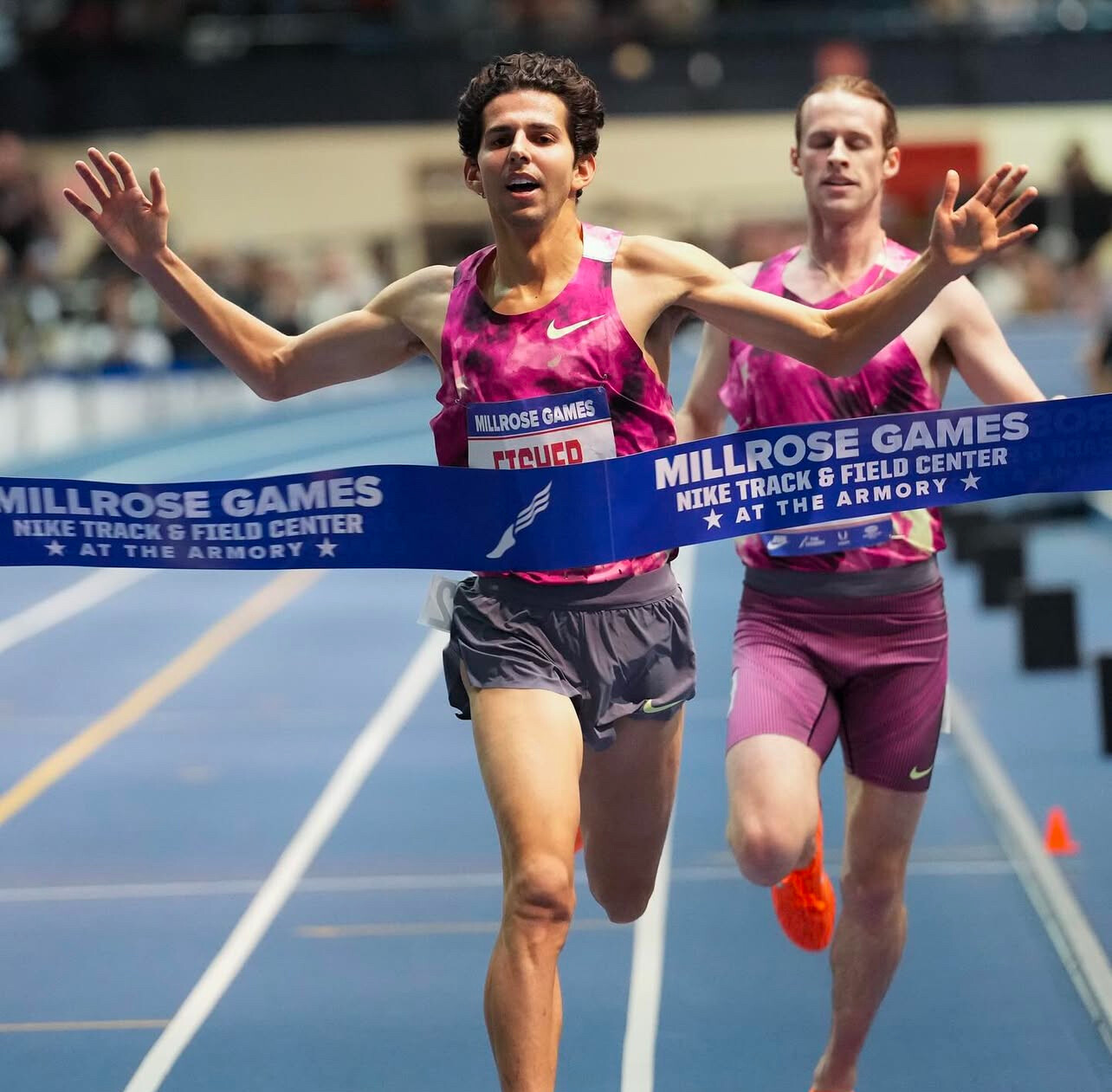
Grant Fisher (USA) and Cole Hocker (USA)—the Olympic 10,000m bronze medalist and 1500m gold medalist, respectively—collided in a tactical masterclass. Fisher’s 7:22.91 broke Lamecha Girma’s world indoor record (7:23.81), with Hocker (7:23.14) also surpassing the old mark . Fisher’s final 200m in 27.50 sealed the win, while France’s Jimmy Gressier (7:30.18) and Australia’s Ky Robinson (7:30.38) set national records .
3. Men’s 800m: Josh Hoey’s American Record Triumph
Josh Hoey (USA) dominated the 800m in 1:43.90, breaking Donovan Brazier’s American indoor record (1:44.21) and holding off Bryce Hoppel (1:44.19 PB) . Sixteen-year-old Cooper Lutkenhaus (1:46.86) smashed the high school record, previously held by Hoey himself .
Women’s Events: Breakthroughs in Mile, 3000m, and 800m

1. Women’s Wanamaker Mile: Georgia Bell’s Tactical Mastery
Georgia Bell (GBR), the Olympic 1500m bronze medalist, edged a stacked field to win in 4:23.35, outkicking Heather MacLean (USA, 4:23.41) and Nikki Hiltz (USA, 4:23.50) . Bell navigated a slow early pace (67.12 for the first quarter-mile) before unleashing a 61.97 final lap, crediting her composure in a “hard and messy” race .
2. Women’s 3000m: Whittni Morgan’s Commanding Victory
Whittni Morgan (USA) surged late to win in 8:28.03, a personal best, ahead of Josette Andrews (USA, 8:29.77) and Sarah Healy (IRL, 8:30.79 NR) . Ethiopia’s Tsigie Gebreselama (8:33.13) and Australia’s Jessica Hull (8:30.91) added depth to a fiercely competitive race .
3. Women’s 800m: Shafiqua Maloney’s Dominance
Shafiqua Maloney (VIN) claimed victory in 1:59.07, fending off a late charge by Addy Wiley (USA, 2:00.14) . Olivia Baker (USA, 2:00.02 PB) and Kaela Edwards (USA, 2:00.14) rounded out the podium in a race showcasing tactical grit .
With world records in the mile (Nuguse) and 3000m (Fisher), plus a slew of national and age-group marks, the 2025 Millrose Games underscored the rising global standard in middle-distance running. As athletes shift focus to outdoor seasons, these performances set the stage for a thrilling 2025 World Championships.
(02/09/2025) ⚡AMPby Boris Baron
NYRR Millrose Games
The Pinnacle of Indoor Track & Field The NYRR Millrose Games, first held in 1908, remains the premier indoor track and field competition in the United States. The 2025 edition will once again bring the world’s top professional, collegiate, and high school athletes to New York City for a day of thrilling competition. Hosted at the New Balance Track &...
more...Julien Wanders Returns to Naples: European Record Holder Sets Sights on Napoli City Half Marathon
Julien Wanders, the European record holder in the half marathon, is set to make a highly anticipated return to the Napoli City Half Marathon on Sunday, February 23, 2025. The Swiss long-distance runner, renowned for his exceptional speed and endurance, is ready to make his mark once again at this prestigious event.
Wanders holds the European half marathon record with a time of 59:13, achieved in 2019, and previously held the European 10 km record with a time of 27:13. His previous performances have solidified his reputation as one of the finest distance runners of his generation, and his return to Naples comes with even greater ambitions.

In 2022, Wanders delivered a standout performance at the Napoli City Half Marathon, finishing in 1:00:28. While impressive, he now aims to surpass this performance and reaffirm his place among the world’s elite. Reflecting on his return to Naples, Wanders shared, “I have fond memories of Naples. This race holds a special place in my heart, and I see it as a crucial step in my journey back to the world’s top level. I am excited to return and will give my best performance.”

A New Chapter: Training at Altitude in Kenya
To prepare for this race, Wanders has been training intensively in Kenya, a country famous for its high-altitude training environment and as the home of many of the world’s greatest long-distance runners. This rigorous training regimen is a core part of his strategy to regain peak form and achieve a top-level performance in Naples.
Napoli City Half Marathon: A World-Class Race
The Napoli City Half Marathon, organized by Napoli Running, is one of Italy’s premier running events. Known for its fast and flat course, the race attracts elite athletes from around the world. The route offers stunning views of the Gulf of Naples and Mount Vesuvius, providing a picturesque backdrop for participants and spectators alike.
Naples has become Italy’s “capital city of half-marathons,” consistently hosting record-breaking performances. Both the men’s and women’s Italian national records have been set on its course, which is praised for being one of the fastest in Europe. The race also serves as the official opening event of the RunCzech running season, drawing thousands of participants eager to challenge themselves on its renowned course.
Eyes on the Future
For Julien Wanders, the 2025 Napoli City Half Marathon is more than just another competition; it is a pivotal moment in his journey back to the pinnacle of long-distance running. With his undeniable talent, rigorous preparation, and the allure of Naples’ record-breaking course, the stage is set for an unforgettable performance.
As Wanders takes to the streets of Naples, he will not only be competing but also reminding the world why he remains one of Europe’s most accomplished long-distance runners.
(02/08/2025) ⚡AMPby Boris Baron
Napoli City Half Marathon
The Napoli City Half Marathon is the most growing running event in Italy. The race, certified by IAAF / AIMS/ European Athletics, is held inoptimal conditions with an average temperature of 10 ° C. From thewaterfront to the Castel dell'Ovo, the Teatro San Carlo to the Piazzadel Plebiscito, the course will lead you through the most fascinatingareas of the city,...
more...Zariel Macchia: Rising Star in Distance Running and Academics
Zariel "Z" Macchia, an 18-year-old senior at William Floyd High School in Suffolk County, New York, continues to make headlines as a standout talent in American distance running. Her achievements both on and off the track demonstrate her exceptional dedication and potential.
Macchia recently defended her title at the USATF U20 Cross Country Championships in Lubbock, Texas, completing the 6-kilometer course in 21:46 and winning by an impressive 11-second margin. This marked her second consecutive U20 national cross-country title, solidifying her reputation as one of the top young runners in the country. In recognition of this victory, she was named USATF Athlete of the Week.

Beyond athletics, Zariel excels academically and was named the News 12/Bethpage Federal Credit Union Scholar Athlete of the Week. This prestigious accolade, awarded to only 30 student-athletes across Long Island during the 2024-25 school year, included a $1,000 scholarship.

Macchia has also achieved numerous other milestones, including representing Team USA's U20 squad internationally, earning five All-American honors, and securing multiple state championships. She has twice been named Gatorade's New York Girls Cross-Country Player of the Year.
A well-rounded individual, Zariel maintains an A average, serves as captain of her school's science bowl team, and has contributed to her community by establishing an ecological center and tutoring peers. She is committed to balancing her academic and athletic pursuits as she prepares to run cross-country and track at Brigham Young University while pursuing a degree in electrical engineering.
Zariel Macchia'd dedication, work ethic, and remarkable achievements make her a rising star in the world of distance running and a role model for aspiring athletes.
(02/07/2025) ⚡AMP
by Boris Baron
Commonwealth Games 2026: Mile Race Returns and Mixed 4x400m Relay Introduced
The Glasgow 2026 Commonwealth Games will mark a historic shift in athletics, with the reintroduction of the mile race, replacing the traditional 1500m event, and the addition of the mixed 4x400m relay. The Games will take place from July 23 to August 2, 2026, featuring a 10-sport programme across four venues, with Scotstoun Stadium hosting the athletics competitions.
The Return of the Commonwealth Mile

For the first time since 1966, the mile race will make its return, paying tribute to the legendary "Miracle Mile" at the 1954 Vancouver Commonwealth Games, where England’s Roger Bannister and Australia’s John Landy—the first two athletes to break the four-minute barrier—battled head-to-head in one of the most iconic races in history.
World Athletics President Sebastian Coe welcomed the decision, emphasizing the mile’s significance within the Commonwealth:
"The one mile is the quintessential Commonwealth athletics event whose return to the Games in Glasgow 2026 I very much welcome. The mile is easy to understand—four laps of the track—and remains a standard everyday measurement across the Commonwealth."
He further highlighted the race’s rich legacy:
"From 1930 through to 1966, the mile was the blue-riband event of each Games. Its place in international sports lore was secured when Sir Roger Bannister broke the four-minute barrier in May 1954. The magic of the mile continues to resonate with sports fans, and a ticket to watch its Commonwealth final will be one of the must-have seats in Glasgow next year."
New Additions: Mixed 4x400m Relay and Expanded Para Athletics Programme
Alongside the return of the mile, the mixed 4x400m relay will be introduced, further enhancing the athletics programme. Additionally, for the first time in Commonwealth Games history, para athletes will compete across all three major disciplines—jumping, throwing, and track events—cementing a new era of inclusivity in the sport.
The full event lineup is available on the Glasgow 2026 Commonwealth Games website, showcasing a programme designed to honor tradition while embracing innovation.
(02/07/2025) ⚡AMPby Boris Baron
The Commonwealth Games
The Commonwealth Games are coming to Victoria - bringing an action packed sports program to our regional cities and delivering a long-term legacy for our future. From 17 to 29 March 2026, Geelong, Bendigo, Ballarat, Gippsland and Shepparton will be on the world stage, attracting millions of viewers and creating thousands of jobs. The multi-city model will...
more...Jacob Kiplimo Set for Marathon Debut at London 2025
Ugandan long-distance star Jacob Kiplimo has announced that he will make his marathon debut at the 2025 London Marathon in April. Speaking to Xinhua on Wednesday, Kiplimo expressed his excitement and determination as he prepares for the challenge.
"I am preparing well because I'am looking forward to making my first appearance in a marathon," Kiplimo said. "I am following the training schedules designed by my coach with full commitment. It is tough, but I have to complete it, knowing that the marathon is not easy."

Kiplimo, 23, is one of Uganda's most accomplished distance runners. He won a bronze medal in the 10,000m at the Tokyo Olympics and holds the half marathon world record (57:31). His transition to the marathon is highly anticipated, as he will face off against some of the world's best, including Kenya's Eliud Kipchoge and Sebastian Sawe.
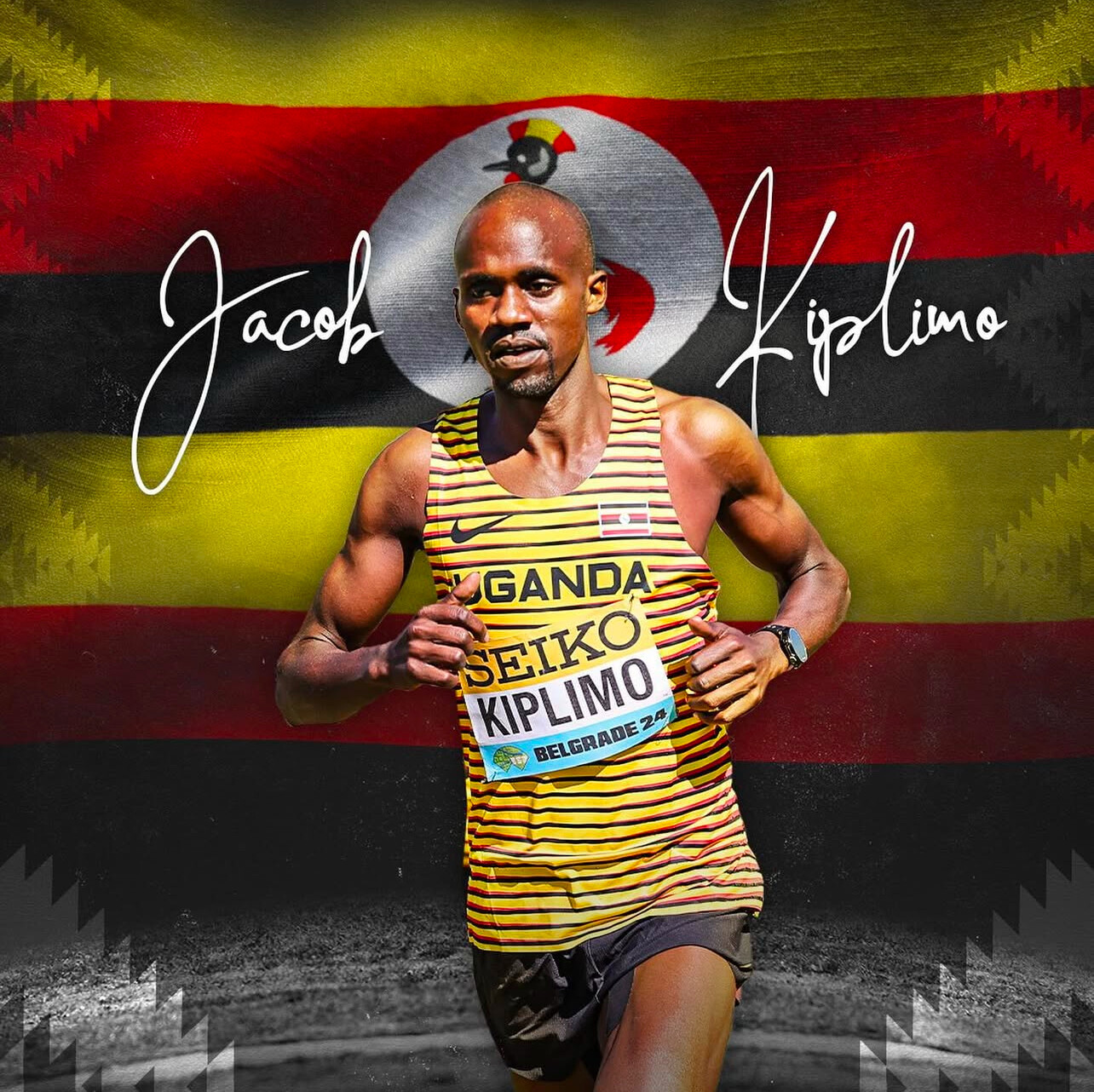
His coach, Peter Chelangat, affirmed that Kiplimo is making solid progress in training. "We are building his endurance for the 42-kilometer race through intense workouts and competitions leading up to the event," Chelangat said.
The president of the Uganda Athletics Federation (UAF), Dominic Otuchet, expressed confidence in Kiplimo's ability to excel in the marathon. "The marathon is challenging, but our long-distance athletes have what it takes to succeed. I am optimistic that he will perform well."
Kiplimo's marathon debut will be closely watched as he takes on the next big step in his already stellar career.
(02/05/2025) ⚡AMP
by Boris Baron
TCS London Marathon
The London Marathon was first run on March 29, 1981 and has been held in the spring of every year since 2010. It is sponsored by Virgin Money and was founded by the former Olympic champion and journalist Chris Brasher and Welsh athlete John Disley. It is organized by Hugh Brasher (son of Chris) as Race Director and Nick Bitel...
more...Richard Ringer Set for a Competitive Return to Hamburg Marathon
European Marathon Champion Richard Ringer is set to compete in the Haspa Marathon Hamburg on April 27. The German runner has opted not to defend his continental title at the European Championships earlier in April, which will be held in a new format.
Ringer, who improved his marathon personal best to 2:05:46 in Valencia last December, making him the third-fastest German marathoner in history, will face stiff competition from at least four athletes who have run significantly faster times. Leading the start list is former London Marathon winner Amos Kipruto, who holds a personal best of 2:03:13, making him the joint fastest entrant ever in Germany's premier spring marathon.

"We are still finalizing the elite fields, but we anticipate a highly competitive men's race. Based on the fastest runners in the field, this will be the strongest lineup in our history. Richard Ringer may not be the favorite, but we know he has the ability to deliver an unexpected performance," said chief organizer Frank Thaleiser at a press conference in Hamburg. A total of 15,000 runners have registered for the 39th edition of the Haspa Marathon Hamburg, marking the highest participation in years.
For the first time, Hamburg will feature three athletes with personal bests under 2:04. In addition to Amos Kipruto, Ethiopian runners Guye Adola and Kinde Atanaw have also achieved this feat. The 32-year-old Kipruto recorded his personal best of 2:03:13 when finishing second to Eliud Kipchoge in the 2022 Tokyo Marathon.
Later that year, he secured his biggest career victory, winning the London Marathon in 2:04:39. Kipruto has continued to perform at a high level, running sub-2:05 times in both 2023 and 2024. His best time ties him as the fastest entrant in Hamburg's marathon history, equaling the record set by Emmanuel Mutai in 2018.

Guye Adola's personal best of 2:03:46 places him second on the current entry list. The Ethiopian achieved this mark in his marathon debut in Berlin in 2017, where he challenged Kipchoge until the final kilometers and secured second place with an unofficial world debut record. Although his career has been affected by injuries, Adola, now 34, remains a formidable contender.
Kinde Atanaw achieved his best time of 2:03:51 in 2019 when he won the Valencia Marathon. Meanwhile, Philemon Kiplimo has demonstrated strong recent performances, breaking 2:05 in Berlin in 2023 with a time of 2:04:56 and securing third place in last year's Haspa Marathon Hamburg with 2:05:37.
Richard Ringer chose to focus on Germany's biggest spring marathon rather than defend his European title. The 35-year-old returns to Hamburg with fond memories, having improved to 2:08:08 there two years ago, narrowly meeting the Olympic qualifying standard and finishing sixth in a competitive field.
"The course and the atmosphere at the Haspa Marathon Hamburg are fantastic. Choosing to return was an easy decision. This time, my training will be even more focused on this race to ensure I am in peak form on race day," Ringer stated. "My goal for the summer is to compete in the marathon at the World Championships." Ringer has proven himself to be a strong championship competitor, having won the European marathon title in Munich in 2022 and finishing as Germany's top runner in the Olympic marathons of 2021 and 2024, placing 25th and 12th, respectively.
(02/05/2025) ⚡AMPHaspa Marathon Hamburg
The HASPA MARATHON HAMBURG is Germany’s biggest spring marathon and since 1986 the first one to paint the blue line on the roads. Hamburcourse record is fast (2:05:30), the metropolitan city (1.8 million residents) lets the euphoric atmosphere spill over and carry you to the finish. Make this experience first hand and follow the Blue Line....
more...Emotions Run High at the 73rd Beppu-Oita Mainichi Marathon
The 73rd Beppu-Oita Mainichi Marathon, held on February 2, 2025, brought together a stunning combination of athletic excellence and heartfelt moments. The iconic race began at Takasakiyama and concluded at J-Lease Stadium, covering 42.195 kilometers through the picturesque cities of Oita and Beppu. As one of the key selection events for Japan's representatives at the 2025 World Athletics Championships, the competition carried high stakes and delivered unforgettable performances.
Kenyan runner Vincent Kipchumba delivered a commanding performance, crossing the finish line in 2 hours, 6 minutes, and 1 second to set a new course record. His exceptional run surpassed previous bests and further established him as one of the elite marathoners of the year. Kipchumba's triumph reflected not only his incredible speed and endurance but also the meticulous preparation that led to his record-breaking success.
Hikaru Wakabayashi, representing Aoyama Gakuin University, made a sensational marathon debut with a time of 2 hours, 6 minutes, and 7 seconds, finishing just seconds behind Kipchumba. His performance not only secured him the title of top Japanese finisher but also marked the beginning of what promises to be an extraordinary career. With his strong showing, Wakabayashi demonstrated remarkable potential and captured the attention of fans and experts alike.
The day was also marked by an emotional farewell to a beloved Japanese athlete competing in their final professional marathon. The streets were lined with fans who cheered them on as they completed their last race, celebrating a career that inspired countless runners and brought pride to the nation.
The women's competition added further excitement to the day, showcasing incredible determination and fierce competition as athletes vied for victory and personal bests. Yamaguchi Haruka claimed first place with a time of 2:36:51, followed by Fujisawa Mai in 2:47:31, and Nakamura Mika in 2:48:23.
As the event concluded, the 73rd Beppu-Oita Mainichi Marathon stood out as a celebration of resilience, ambition, and sportsmanship. From record-breaking achievements to poignant goodbyes, the race reminded everyone of the beauty and drama that make marathons such a beloved sport.
(02/04/2025) ⚡AMP
Record-Breaking Performances Shine at Czech Indoor Gala in Ostrava
World indoor 1500m champion Freweyni Hailu delivered one of the fastest 3000m performances of all time at the Czech Indoor Gala—the fourth World Athletics Indoor Tour Gold meeting of the season—held in Ostrava on Tuesday (4).
Competing in just the third 3000m race of her career, the Ethiopian 23-year-old dominated with an 8:24.17 season opener, moving her to eighth on the world all-time list. Following a 2:52.08 split at 1000m and hitting 2000m in 5:45.8, Hailu surged over the final five laps, closing the last kilometre in 2:39 to secure victory.
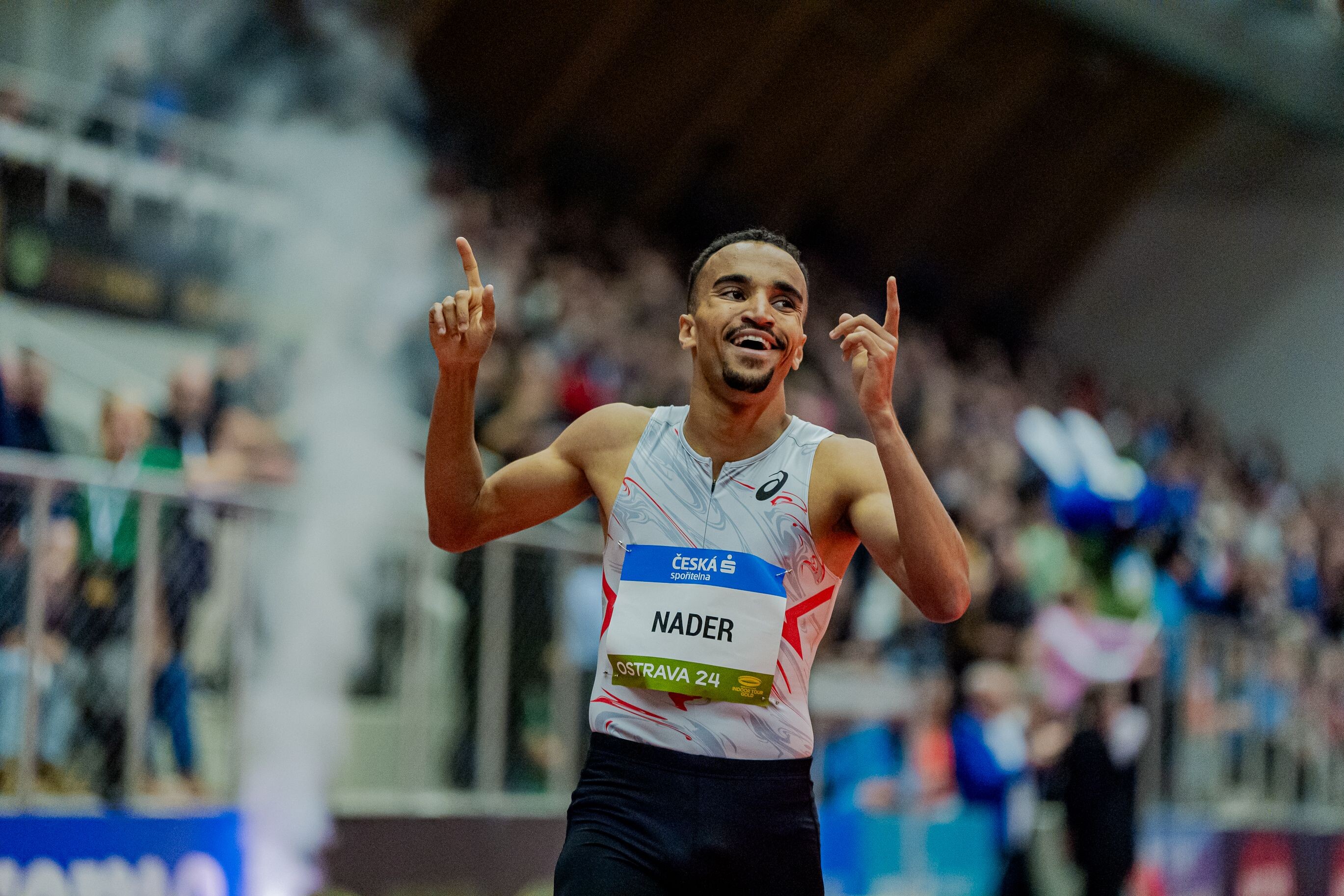
Portugal’s Salome Afonso, who ran with Hailu in the early stages, finished second in a personal best of 8:39.25, followed closely by Kenya’s Purity Kajuju Gitonga in 8:39.36. Great Britain’s 18-year-old Innes FitzGerald shattered the European indoor U20 record by over 10 seconds, running 8:40.05 to claim fourth place.

The men’s 800m also saw a standout performance, with Belgium’s Eliott Crestan breaking the 1:45 barrier indoors for the first time, clocking a national record of 1:44.69 in his season debut. The world indoor bronze medallist improved on his previous best of 1:45.08 from last year’s World Indoor Championships in Glasgow, securing 12th place on the world all-time list. Italy’s Catalin Tecuceanu finished second in 1:45.35, while Algeria’s Slimane Moula, making his indoor debut, took third in 1:45.50.
In the women’s 800m, Gabriela Gajanova emerged victorious in 2:02.16, overtaking world indoor bronze medallist Noelie Yarigo in the final 150m as Yarigo faded in the closing stretch.
Meanwhile, Portugal’s Isaac Nader continued his dominance in Ostrava, setting his second consecutive meeting record with a 3:54.17 mile after breaking the 1500m record last year. He surged past Great Britain’s Elliot Giles in the home straight, with Giles finishing second in 3:54.62 in his first indoor race since 2022. Sweden’s Samuel Pihlstrom also made history, running a Swedish indoor record of 3:54.78 to place third.
With multiple meeting records shattered and world-leading times set, the Czech Indoor Gala in Ostrava reaffirmed its status as a premier stop on the World Athletics Indoor Tour Gold circuit.
(02/04/2025) ⚡AMPSadie Engelhardt: Rising Star Shines with Historic Indoor Mile Performance
On February 2, 2025, at the New Balance Indoor Grand Prix in Boston, Sadie Engelhardt, a senior from Ventura High School in California, delivered a remarkable performance by completing the mile in 4:29.34. This achievement ranks as the second-fastest indoor mile in U.S. high school history, trailing only Mary Cain's 2013 record of 4:28.25.
Engelhardt's journey in track and field began in elementary school, where she participated in cross country at Poinsettia Elementary in Ventura. Initially, running served as conditioning for her primary passion, soccer. However, by eighth grade, after clocking a 4:40 mile, she recognized her exceptional talent and shifted her focus to track.

Throughout her tenure at Ventura High School, Engelhardt has consistently broken records and garnered accolades. In 2022, she became the California State Champion and set an all-time record in the 1600 meters at the Arcadia Invitational. The following year, she achieved a historic double at the CIF State Track and Field Championships in Clovis, winning both the 1600-meter and 800-meter events. Notably, she set a meet record in the 1600 meters with a time of 4:33.45, a feat last accomplished in 1975.
Academically, Engelhardt has maintained a weighted 4.59 GPA and has committed to competing on scholarship at North Carolina State University starting in the fall of 2025.

Reflecting on her recent performance, Engelhardt emphasized the importance of enjoying the journey, stating, "I'm still in high school, so this is like the fun part before it gets really serious in college and (at the) professional level, so just doing my best."
Engelhardt's blend of academic excellence, athletic prowess, and grounded perspective underscores her as a standout figure in high school athletics. As she continues to break barriers, the track and field community eagerly anticipates her future endeavors.
(02/03/2025) ⚡AMPAlexander Mutiso and Dolphine Omare Shine at the 77th Kagawa Marugame International Half Marathon
Marugame, Japan – February 2, 2025 – The 77th Kagawa Marugame International Half Marathon witnessed an electrifying display of endurance and speed as top athletes from around the world delivered record-breaking performances on the fast and flat course in Marugame City, Kagawa Prefecture.
Mutiso Claims Men’s Title with a Course Record

In the men’s race, Kenya’s Alexander Mutiso produced a dominant performance, crossing the finish line in 59 minutes and 16 seconds, setting a new course record. Mutiso, known for his blistering pace and strong finishing kick, edged out fellow Kenyan Maru Emmanuel, who secured second place with an impressive time of 59:19.
Japan’s Ota Tomoki followed closely, clocking 59:27 to claim third place, while his compatriot Shinohara Kotaro finished just three seconds later in 59:30, rounding out the top four. The strong performances by the Japanese duo demonstrated the rising competitiveness of homegrown talent on the international stage.
Men’s Top 4 Results:
1. Alexander Mutiso(Kenya) – 59:16
2. Maru Emmanuel(Kenya) – 59:19
3. Ota Tomoki(Japan) – 59:27
4. Shinohara Kotaro(Japan) – 59:30
Dolphine Omare Dominates Women’s Race
The women’s race was equally thrilling, with Kenya’s Dolphine Nyaboke Omare storming to victory in 1 hour, 6 minutes, and 5 seconds. Her powerful run shattered the previous course record, firmly establishing her as one of the rising stars in women’s long-distance running.
Great Britain’s Calli Hauger Thacker delivered a strong performance, finishing second in 1:06:58, while Australia’s Isobel Batt-Doyle claimed third place in 1:07:17, setting a new Australian national record. Pauline Kaveke Kamulu of Kenya secured fourth place with a time of 1:07:33, further showcasing the strength of Kenyan athletes on the international stage.
Women’s Top 4 Results:
1. Dolphine Nyaboke Omare(Kenya) – 1:06:05 (Course Record)
2. Calli Hauger Thacker(Great Britain) – 1:06:58
3. Isobel Batt-Doyle(Australia) – 1:07:17 (Australian National Record)
4. Pauline Kaveke Kamulu(Kenya) – 1:07:33
A Historic Event with World-Class Performances
The Kagawa Marugame International Half Marathon, a World Athletics Elite Label race, has long been known for producing fast times and competitive fields. This year was no exception, with multiple athletes breaking records and setting personal bests. The event, which began and ended at Pikara Stadium, featured a flat and scenic course, allowing for optimal conditions for record-breaking performances.
(02/02/2025) ⚡AMPKagawa Marugame Half Marathon
The Kagawa Marugame Half Marathon is an annual road running competition which takes place in early February in Marugame, Japan. It currently holds IAAF Silver Label Road Race status and the professional races attract over 1000 entries each year, and hosted by the Sankei Shimbun, Sankei Sports, Okayama Broadcasting, BS Fuji. The race in Marugame was first held in 1947...
more...Anticipation Builds for Middle-Distance Showdowns at 2025 Czech Indoor Gala
The Czech Indoor Gala, scheduled for February 4, 2025, in Ostrava, is set to feature thrilling middle-distance races, particularly in the men’s 800 meters and the women’s 3000 meters.
Men’s 800 Meters:
Czech national record holder Jakub Dudycha will compete on home soil. As a junior, he set a national U20 indoor record of 1:47.42 at the Czech Indoor Gala, later improving it to 1:47.12. Outdoors, he advanced to the semi-finals at the European Championships in Rome, clocking a time under 1:45, and subsequently set a new Czech senior record of 1:44.82 in Bydgoszcz. Dudycha has expressed his ambition to break the national indoor record this season.
He will face formidable international competitors, including Belgium’s Eliott Crestan, who is the sixth fastest European in history with a national record of 1:42.43 set at the Paris Diamond League meeting. Crestan is a bronze medallist from both the European and World Indoor Championships. Another strong contender is Catalin Tecuceanu, representing Italy since 2022, who secured European bronze in Rome and boasts personal bests of 1:45.00 indoors and 1:43.75 outdoors.
Women’s 3000 Meters:
Kristiina Sasínek Mäki, a Tokyo Olympics finalist, will compete in the 3000 meters. She has been training under Swiss coach Louis Heyer and is eager to showcase her progress. However, she will face stiff competition from African athletes. Ethiopia’s Freweyni Hailu, the 1500m world indoor champion from Glasgow 2024, returns after setting a meeting record in the mile at last year’s Czech Indoor Gala. Joining her is compatriot Sembo Almayew, the junior world record holder in the steeplechase and World U20 champion, as well as Norah Jeruto, the World 3000m steeplechase champion from the 2022 Eugene Championships, now representing Kazakhstan.
The Czech Indoor Gala, part of the World Athletics Indoor Tour Gold series, continues to attract top-tier talent, ensuring a night of exceptional athletic performances in Ostrava.
(02/01/2025) ⚡AMPAlex Matata wins RAK Half Marathon, Ejgayehu Taye runs world leading time
Alex Matata of Kenya had the best win of his career in the 18th edition of the Ras Al Khaimah Half Marathon early today. But strong winds on an unusually cool morning in one of the smaller of the United Arab Emirates meant that Ejgayehu Taye’s attempt at the women’s world record was going to be blown off course, even if she had not started too fast.
The breeze and lack of a pacemaker to split the field meant that the men’s race was relatively sedate as well as over-populated in the first 10k, with 20 men still in contention at 28min 34sec. But there was no mistaking Matata in the pack, channelling Michael Jackson with a pink glove on his right hand. ‘For wiping the sweat, that’s all,’ he explained afterwards. But when colleague and race favourite Isaia Lasoi, who’d been sharing the lead with him up to then started feeling a groin strain, Matata began to assume the initiative.

"I realised at 14k that I was stronger than the others, so I thought I had a good chance of winning,’ he said. He raised the pace such that the computed finish outside 60min was soon transformed, and his relentless front-running dropped both his rivals and the time, and he ended up taking 17sec off his personal best with a win in 59min 20sec.
Lasoi hung in well, and looked to have second place sewn up, especially when Gemechu Dida suddenly dropped back with a kilometre to run; but the Ethiopian rallied and caught the Kenyan just before the line to get second and relegate Lasoi to the same third spot as last year. A stride can be costly in this sport. While Matata took home $20,000, Dida’s last gasp second place earned him $10,000, four thousand more than Lasoi.
Matata is something of an outlier in Kenya, coming from the capital Nairobi instead of the western highlands’ hotbeds of excellence; and also being a relatively late starter in his early twenties. But when he began running well with a 61.03 clocking in the Nairobi half-marathon in 2021, he was persuaded to move up to Eldoret, the heartland of national distance running. Now at 27, a regime of 150 kilometres a week has seen him transformed into a regular winner, with four victories and three sub-60min clockings in his five half-marathons last year. And now, he’s given himself a New Year’s present. But he’s not tempted to move up to the marathon yet. ‘Not for two years. I still want to run faster at the half-marathon, in the 58 minutes and maybe 57 minutes’.
In the women’s race, Ejgayehu Taye was so confident that she could run well that she even brought her own pacemaker, Wosinew Admasu with her. And a starting temperature of 12C (54F) felt good until she headed into the wind. Although the expected contest with her colleage Girmawit Gebrzihair did not materialise (the latter dropped out) things went to plan for the first five kilometres, which she covered in 14min 57sec. But the pace and wind took their toll and she fell further behind her schedule and was grateful to win in 65.52, exactly three minutes outside her target time. ‘I was expecting to run fast, even maybe get the world record, but the wind was too strong; I felt it was pushing me back. But I’m glad to win’. Her time is a world lead for 2025.
Results, Men:
1. Alex Matata KEN 59:20
2. Gemechu Dida ETH 59:25
3. Isaia Lasoi KEN 59:26
4. Chimdessa Debele ETH 59:28
5. Gerba Dibaba ETH 59:35
6. Nibret Melak ETH 59:45
7. Hillary Kipkoech KEN 59:53
8. Tesfaye Deriba ETH 59:56
9. Haftamu Gebresilase ETH 59:56
10. Mao Ako TAN 60:28
Women:
1. Ejgayehu Taye ETH 65:52
2. Judy Kemboi KEN 66:34
3. Jesca Chelangat KEN 66:53
4. Ftaw Zeray ETH 67:05
5. Gete Alemayehu ETH 67:14
6. Adane Anmaw ETH 68:02
7. Veronica Loleo KEN 68:06
8. Lemlem Hailu ETH 68:07
9. Brillian Jepkorir KEN 68:48
10. Betelihem Afenigus ETH 69:02
(02/01/2025) ⚡AMPRak Half Marathon
The Rak Al Khaimah Half Marathon is the 'world's fastest half marathon' because if you take the top 10 fastest times recorded in RAK for men (and the same for women) and find the average (for each) and then do the same with the top ten fastest recorded times across all races (you can reference the IAAF for this), the...
more...Sprint Showdowns and Distance Battles to Take Center Stage at the New Balance Indoor Grand Prix
The New Balance Indoor Grand Prix, a World Athletics Indoor Tour Gold meeting, is set to deliver thrilling track action in Boston on Sunday (Feb 2), with an elite lineup of global gold medalists ready to ignite the indoor season. The competition will serve as a crucial stepping stone towards the World Athletics Indoor Championships Nanjing 25 in March.
Sprints and Hurdles: Lyles and Alfred Lead the Charge

Olympic and world sprint sensation Noah Lyles returns to defend his 60m title, after setting a meeting record of 6.44 last year. Lyles, who claimed 100m gold and 200m bronze at the Olympics, kicked off his season with a 6.62 win in Gainesville last weekend. He will face Trayvon Bromell (USA), Zharnel Hughes (GBR), and 2022 world indoor champion Marcell Jacobs (ITA), who is making his North American indoor debut.
In the women’s 300m, Olympic 100m champion Julien Alfred steps up in distance for her New Balance Indoor Grand Prix debut. After winning world indoor 60m gold in Glasgow, Alfred took 100m gold and 200m silver at the Olympics and ended last season with a Diamond League Final victory. She faces a competitive field including 2019 world 200m champion Dina Asher-Smith (GBR) and USA’s Lynna Irby-Jackson.
The men’s 300m features Olympic 400m hurdles gold medalist Rai Benjamin. A past winner in Boston, Benjamin is set to battle 4x400m relay star Vernon Norwood and Matthew Boling.

The 60m hurdles events promise fireworks, with world record-holder Devynne Charlton (7.65) and Olympic champion Masai Russell renewing their rivalry. Russell edged Charlton in their recent clash in Lubbock, but the Bahamian sprinter leads their head-to-head series 8-2. Joining them are Olympic finalists Ackera Nugent, Grace Stark, and 2018 world indoor silver medallist Christina Clemons.
For the men, world record-holder Grant Holloway (7.27) looks to extend his 10-year unbeaten streak in the 60m hurdles. The Olympic and world champion headlines the field alongside Olympic finalist Freddie Crittenden and 2022 world silver medallist Trey Cunningham.
Middle and Long Distance Races: Olympic Medalists Face Off
The women’s 3000m sees Olympic 1500m silver medalist Jessica Hull (AUS) take on Great Britain’s Olympic bronze medalist Georgia Bell. Hull, the defending champion, set an Oceanian indoor record of 8:24.93 in this event last year. They are joined by USA’s Parker Valby, Emily Mackay, Elise Cranny, Ethiopia’s Melknat Wudu, Italy’s Sintayehu Vissa, and Olympic steeplechase medalist Emma Coburn.
In the men’s 1500m, USA’s Grant Fisher (Olympic 5000m and 10,000m bronze medalist) takes on 2022 world champion Jake Wightman (GBR), Oliver Hoare (AUS), and Josh Hoey, who recently broke the North American 1000m record.
Bryce Hoppel, the reigning world indoor 800m champion, leads the men’s 800m field, while Hobbs Kessler, Cameron Myers, Neil Gourley, and Andrew Coscoran battle in the 3000m.
Other Key Events
Women’s 60m: Mikiah Brisco (USA) and Zoe Hobbs (NZL) lead the field.
Men’s 400m: 2022 world indoor champion Jereem Richards (TTO) races USA’s Quincy Wilson.
Women’s 500m: Dutch 4x400m Olympic champion Lisanne de Witte takes on USA’s Olympic 800m medallist Raevyn Rogers.
Women’s Mile: Heather MacLean (2023 winner) faces Olympic finalist Susan Ejore, Maia Ramsden, and Sage Hurta-Klecker.
With an electrifying lineup of Olympic and world champions, the New Balance Indoor Grand Prix promises high-stakes racing and a preview of the talent heading to Nanjing 25.
(01/31/2025) ⚡AMPby Boris Baron
Eilish McColgan Set for Marathon Debut at 2025 London Marathon
Eilish McColgan, the accomplished British distance runner, is poised to make her marathon debut at the 2025 TCS London Marathon on April 27. This event holds special significance, as her mother, Liz McColgan, clinched victory in the same race in 1996.
Eilish's journey to the marathon has been marked by both triumphs and challenges. In early 2023, she was prepared to compete in the London Marathon; however, a knee injury forced her to withdraw just days before the event. Reflecting on the setback, she expressed her frustration, stating, "It was frustrating not to showcase the form I felt I was in, and get a race out of all the hard work I had put into it." Undeterred, McColgan set her sights on making her marathon debut in 2025.

The announcement of her participation in the 2025 London Marathon was met with enthusiasm, especially given the familial legacy associated with the event. Eilish shared her excitement, saying, "I am really looking forward to making my marathon debut in London this year. After a tough 12 months of injury, I am excited to finally toe the line and start the next chapter of my career on the roads."
Beyond her marathon aspirations, McColgan has an impressive track record in distance running. She secured a gold medal in the 10,000 meters at the 2022 Commonwealth Games, setting a new Games record with a time of 30:48.60. Additionally, she holds British records in the 5,000 meters, 10,000 meters, and the half marathon, underscoring her versatility and endurance across various distances.
As the 2025 London Marathon approaches, anticipation builds to see how Eilish McColgan will perform in her marathon debut, following in the footsteps of her mother and adding a new chapter to her distinguished running career.

(01/30/2025) ⚡AMP
by Boris Baron
TCS London Marathon
The London Marathon was first run on March 29, 1981 and has been held in the spring of every year since 2010. It is sponsored by Virgin Money and was founded by the former Olympic champion and journalist Chris Brasher and Welsh athlete John Disley. It is organized by Hugh Brasher (son of Chris) as Race Director and Nick Bitel...
more...Women Take Center Stage at the 2025 RAK Half Marathon
The women’s race is set to steal the spotlight at the 18th edition of the Ras Al Khaimah Half Marathon on Saturday morning (February 1), with Ethiopian stars Girmawit Gebrzihair and Ejgayehu Taye both declaring their intent to chase the world record. Meanwhile, Kenya’s Isaia Lasoi, the fastest man in the field, is equally determined to go for victory and potentially set a new global mark himself.
The battle between the Ethiopian women promises to be fascinating, as both share a personal best of 64:14. Girmawit, who set that time when she won this race three years ago, still holds the course record. She admitted at the pre-race press conference that she surprised even herself with that performance, but after clocking a sub-30-minute 10K in Valencia just two weeks ago, she believes Letesenbet Gidey’s world record of 62:52 is within her reach.

Ejgayehu, on the other hand, ran her 64:14 in her half marathon debut in Valencia three months ago. She is so confident of running fast that she has brought her own pacemaker to help push the pace. Her agent, Yonas Mekonnon, explained: “She decided to go for the world record based on her recent training. She ran just over 64 minutes in Valencia with limited mileage, having trained for no more than six weeks after the track season. Her longest run was only 25km. This time, however, she has regularly been covering more than 28km at a 3:30/km pace at altitude. Her goal in this race is the world record.”
Women have played a defining role in the nearly two-decade history of the RAK Half Marathon. While Kenya’s Sammy Wanjiru set a men’s world record in the inaugural edition in 2007, the women have since taken center stage, with world records being set by Mary Keitany and Peres Jepchirchir of Kenya, and Ababel Yeshaneh of Ethiopia.
Among the men, Lasoi is the clear favorite. With a personal best of 58:10 from Copenhagen last autumn, he is the fastest in the field by a significant margin. He is also hoping to follow in the footsteps of past RAK winners who climbed the podium before taking victory. Having finished third last year, he is eager to claim the top spot. “I’ve been running 175-190 kilometers per week in training. I’ve prepared really well and I’m ready to win,” he said. “Also, there have been some changes to the course that make it faster. I think I can go under 58 minutes, and maybe even challenge the world record.”

Last year’s race saw strong winds and thick mist rolling in from the sea, affecting the final stages. However, the forecast for this year couldn’t be better, with ideal racing conditions of 15-16°C (60°F) expected for the elite start at 6:40 AM.
Now in their second year of overseeing the RAK Half, the long-time Dubai Marathon organizers, Pace Events, have significantly boosted participation across all events, including the 2K, 5K, and 10K races, pushing total registrations close to 10,000. Iyad Rasbey, VP of the RAK Tourism Development Authority, remarked, “When the event began in 2007, we were aiming for 2,500-3,000 participants. To be nearing 10,000 is extraordinary.”
With perfect conditions, a deep field, and multiple world record ambitions, the 2025 RAK Half Marathon is poised for a historic edition.
(01/30/2025) ⚡AMPRak Half Marathon
The Rak Al Khaimah Half Marathon is the 'world's fastest half marathon' because if you take the top 10 fastest times recorded in RAK for men (and the same for women) and find the average (for each) and then do the same with the top ten fastest recorded times across all races (you can reference the IAAF for this), the...
more...Grant Fisher Clocks a sub Four-Minute Mile to Conclude a 7K Workout
Grant Fisher, one of America's top distance runners, continues to showcase his exceptional fitness and race-readiness. In a recent Track workout Grant closed a demanding 7-kilometer workout with a stunning sub four-minute mile, demonstrating his world-class endurance and speed. The session, held in Chandler, Arizona, was designed to simulate race conditions, ensuring that Fisher is primed for his upcoming season opener.
A Closer Look at the Workout
The workout was structured to test Fisher’s ability to maintain a high level of performance deep into a training session. His coach, Mike Scannell, closely monitored his effort, emphasizing the of controlled fatigue management.
The workout breakdown:

First Segment: A 2,000-meter interval, completed in 5:08.
Second Segment: Four 800-meter repeats, split in 2:06, 2:09, 2:08, and 2:08.
Final Segment: A 1,600-meter effort, where Fisher clocked an astonishing sub 4:00 mile to finish the session.
Between intervals, Fisher took controlled recovery breaks, with coach Scannell monitoring his blood lactate levels to ensure he remained within an optimal training range. Professional runner Sam Gilman assisted in pacing certain portions of the session, helping maintain consistency and push Fisher to his best effort.
A Career Defined by Breaking Barriers
Fisher’s ability to produce elite performances at the highest level is no surprise. Born on April 22, 1997, in Calgary, Alberta, and raised in Grand Blanc, Michigan, Fisher made history as a high schooler when he became the seventh U.S. prep athlete to break the four-minute mile barrier. He achieved this milestone in 2015 at the Festival of Miles in St. Louis, Missouri, clocking a 3:59.38.
After high school, Fisher attended Stanford University, where he further cemented his reputation as a distance-running star. Under coach Chris Miltenberg, he won the 2017 NCAA 5,000m title and earned 12 All-American honors. Fisher’s consistency and tactical intelligence on the track made him one of the most accomplished distance runners in Stanford history.
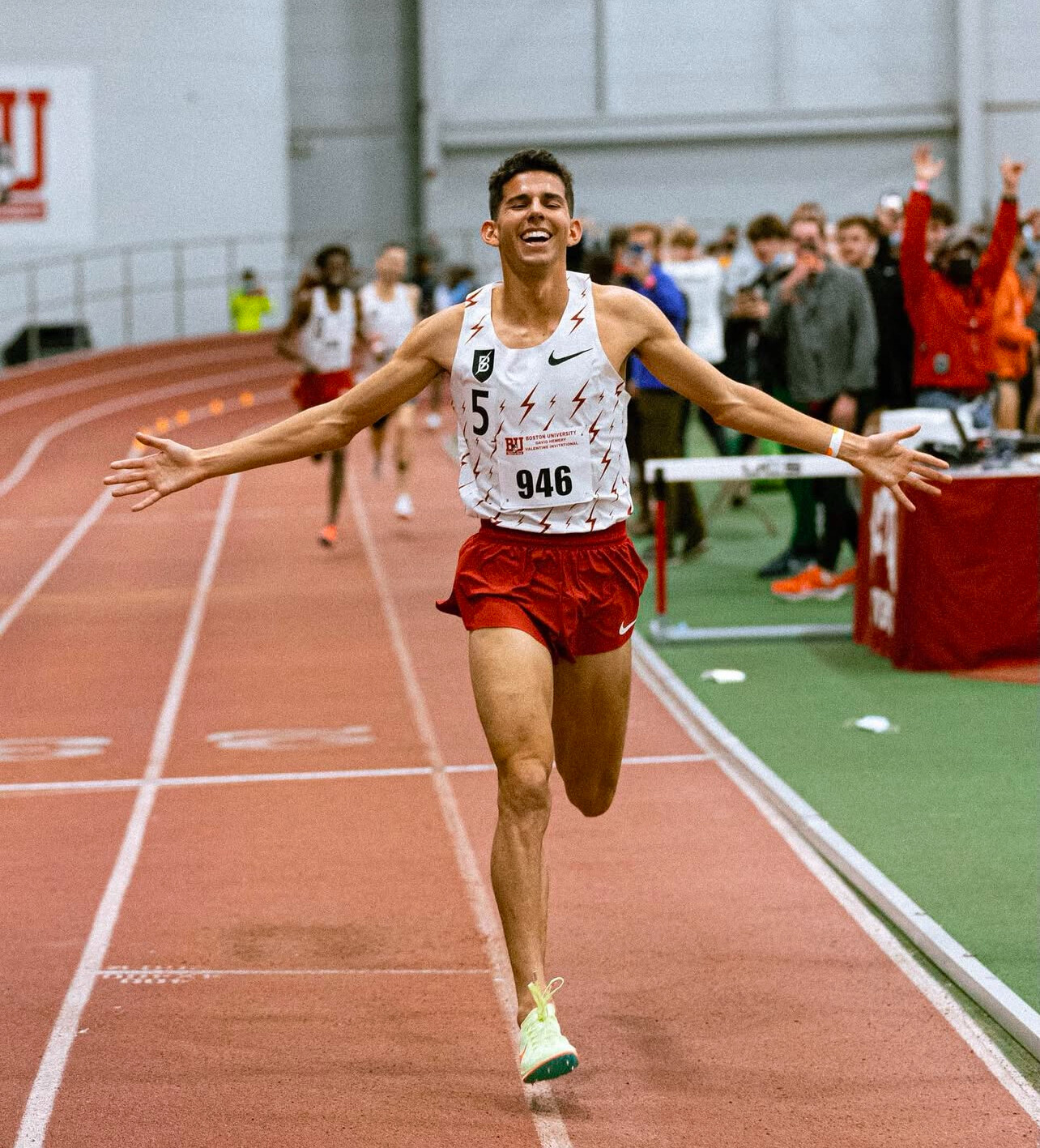
Turning professional in 2019, Fisher joined the Bowerman Track Club (BTC), training under coach Jerry Schumacher. The move propelled his career to new heights, as he set multiple American records, including:
3,000m: 7:25.47 (2023)
Two-mile: 8:03.62 (2023)
5,000m: 12:46.96 (2022)
10,000m: 26:33.84 (2022)
His performances placed him among the best distance runners in the world. At the Tokyo 2020 Olympics (held in 2021), he finished fifth in the 10,000m and ninth in the 5,000m, proving he could compete at the sport’s highest level.
Paris 2024 and Beyond
Fisher’s steady progression led to historic achievements at the 2024 Paris Olympics, where he became the first American to medal in both the 5,000m and 10,000m in the same Games, earning two bronze medals. This feat solidified his status as one of America’s greatest-ever distance runners.
As he prepares for the 2025 season, Fisher is expected to begin his campaign with a 1,500-meter race at the New Balance Indoor Grand Prix in Boston before focusing on the 3,000m and 5,000m during the indoor season. His long-term goal remains clear: to position himself as a gold medal contender at the 2028 Los Angeles Olympics.
Fisher’s ability to run a sub four-minute mile at the end of an intense workout speaks volumes about his fitness level and training discipline. As he continues to sharpen his form, fans can expect even greater performances from him in the coming months.
(01/29/2025) ⚡AMPby Boris Baron
Harnessing Muscle Memory: Returning to Running After a Break
After taking a break from running, you might be pleasantly surprised to find that your legs instinctively remember the rhythm and motion once you lace up again. This phenomenon, known as muscle memory, allows previously trained muscles to quickly regain strength and coordination, even after extended periods of inactivity.
Understanding Muscle Memory
Muscle memory refers to the process by which repetitive physical activities are ingrained into your neuromuscular system, enabling movements to become more automatic over time. When you engage in activities like running, your brain and muscles develop a synchronized pattern through consistent practice. Even after a break, these established neural pathways facilitate a quicker return to form.
The Science Behind Muscle Memory

Research indicates that after a period of detraining, muscles can rapidly regain strength upon resumption of activity. A study from the University of Jyväskylä found that participants who took a 10-week break from strength training were able to return to their previous strength levels within five weeks of retraining. This suggests that the neuromuscular adaptations from prior training persist, allowing for efficient reacquisition of strength and coordination.
Maximizing Muscle Memory in Running
To harness the benefits of muscle memory and ensure a smooth transition back into running, consider the following strategies:
Start Slowly: Begin with shorter, less intense runs to allow your muscles and joints to readjust. Gradually increase your mileage and intensity to prevent overuse injuries.

Incorporate Strength Training: Engage in resistance exercises targeting key running muscles, such as the quadriceps, hamstrings, and calves. Strengthening these areas supports better performance and reduces injury risk.
Prioritize Flexibility: Regular stretching, especially of the lower body, enhances flexibility and aids in maintaining proper running form. Dynamic stretches before runs and static stretches afterward can be beneficial.
Listen to Your Body: Pay attention to any discomfort or pain. It's essential to differentiate between normal post-exercise soreness and potential injury signals. Rest as needed to allow for adequate recovery.
Maintain Consistency: Establish a regular running schedule to reinforce neuromuscular patterns and build endurance. Consistency is key to reestablishing and strengthening muscle memory.
Muscle memory serves as a valuable ally when returning to running after a break. By understanding and leveraging this phenomenon, you can ease back into your routine more effectively, reducing the risk of injury and enhancing overall performance. Remember to progress gradually, incorporate complementary strength and flexibility exercises, and listen to your body's signals to make the most of your return to running.
(01/29/2025) ⚡AMPby Boris Baron
Pushing the Limits: Sophie Power Sets a New Women’s 48-Hour Treadmill World Record
The treadmill, often seen as a monotonous exercise machine, became a stage for human endurance and determination when ultrarunner and campaigner Sophie Power set a remarkable new world record. At this year's National Running Show, Sophie achieved the seemingly impossible, running 370.9 kilometers (230.5 miles) on a treadmill in 48 hours non-stop. This astonishing feat earned her the women's 48-hour treadmill world record, inspiring countless others to challenge their limits.
Sophie, a mother and well-known advocate for women in sports, approached the challenge with her characteristic determination and grit. She demonstrated not just physical endurance but also mental resilience, as running continuously on a treadmill for two days tests the mind as much as the body. "The treadmill is a space where you can push your boundaries, where it's just you and your willpower," Sophie shared after her record-breaking performance.

Her journey to this achievement wasn't without its difficulties. Sophie balanced a strict training regimen with her personal and professional commitments. As an ultrarunner, she is no stranger to grueling physical challenges, having previously competed in some of the toughest endurance races worldwide. But the treadmill, an environment devoid of changing scenery and external stimuli, posed a unique and formidable challenge.
The National Running Show provided the perfect backdrop for Sophie's attempt, with spectators and supporters cheering her on through every step of her journey. The energy from the crowd fueled her determination, proving the power of community and encouragement in achieving seemingly insurmountable goals.

Sophie's record stands as a testament to human capability and the idea that limits exist only in the mind. By running over 370 kilometers in two days, she not only set a new benchmark in the world of ultrarunning but also inspired countless others to embrace challenges, however daunting they may seem.
Her accomplishment reminds us all that with determination, preparation, and resilience, we can achieve extraordinary things even on a treadmill.
(01/28/2025) ⚡AMP
by Boris Baron
Banking Miles Early: My Approach to Racing 5Ks, 10Ks, and Half Marathons in My 50's
When I was racing 5Ks, 10Ks, and half marathons at sub-6-minute pace back in my 50s, I had a strategy that worked for me, banking miles early and then hanging on. It wasn't a tactic I consciously developed; it just seemed natural to me. Start strong, build a cushion, and fight to the finish.
One of my proudest moments was at the Carlsbad 5000 when I was 49. I clocked 17:09 for the 5K, hitting the first mile in 5:11. Maybe I went out a little too fast, but I managed to hang on and finish strong. That race epitomized my approach, push hard early, stay focused, and keep fighting.
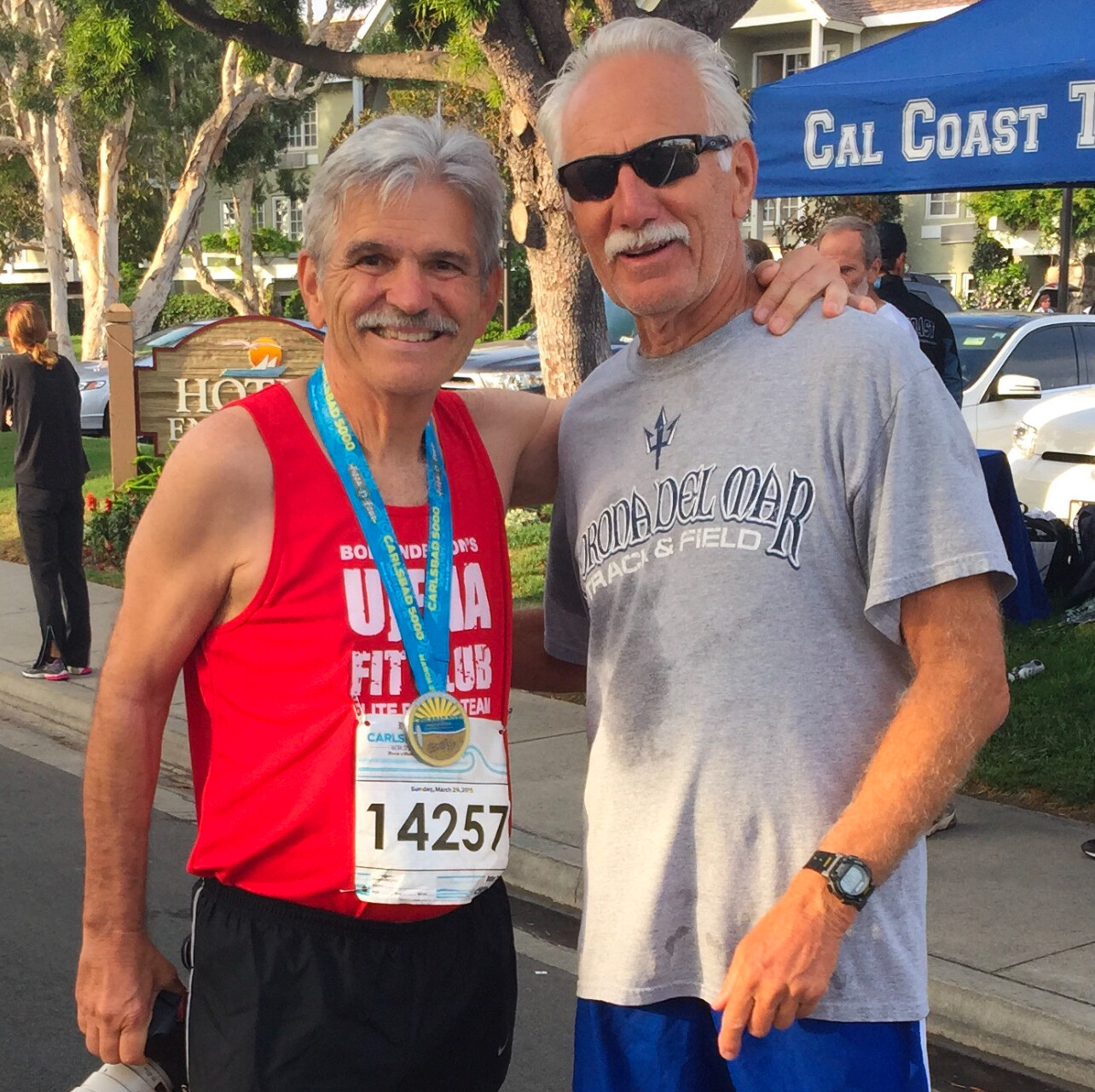
Another memorable race was my best 10K, where I clocked a 35:24. I hit the first mile in 5:17. By miles 4 and 5, I inevitably slowed down, but I found a way to come back strong and finish hard. It wasn't a perfect negative split, but it worked for me.
The question I've often wondered is: Could I have run faster if I had started slower? I'll never know because I never raced that way. For me, the surge of adrenaline and the psychological boost of being ahead of my target pace gave me the confidence to push through the inevitable fatigue.
Of course, not everyone races this way. Conventional wisdom suggests a more even-paced strategy might be more efficient, especially for longer distances. But for me, the thrill of starting strong and the challenge of holding on worked, at least in the 5K, 10K, and half-marathon distances.

Would I recommend this approach to others? Maybe, but with caution. It depends on your training, fitness level, and mental game. Banking miles early isn't for everyone, but for those who thrive on pushing hard and holding on, it can be a rewarding way to race.
Looking back, I am proud of those performances. Whether or not starting slower would have made me faster, I can say that racing hard from the gun gave me some of my most satisfying moments as a runner. It's a strategy that suited me, and that's what matters most.
(01/27/2025) ⚡AMP
by Boris Baron
Do Compression Socks Actually Help Runners Run Faster?
One of the most common claims about compression socks is their ability to enhance running performance. For runners, the idea of gaining even a slight edge during training or a race is appealing. But do compression socks really help runners achieve faster times?
The Science Behind Compression Socks and Speed
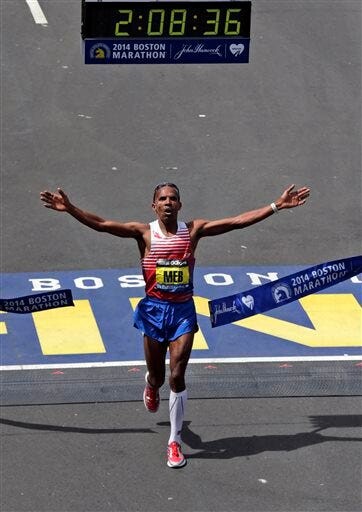
1. Improved Circulation
Compression socks are designed to promote blood flow by applying graduated pressure to the legs, with the tightest compression at the ankle and gradually decreasing up the calf. By improving circulation, these socks ensure that oxygen-rich blood is delivered more efficiently to working muscles, which may delay the onset of fatigue and help runners sustain their pace longer.
2. Reduced Muscle Vibration

When running, the constant impact with the ground causes muscle vibrations, which can lead to fatigue over time. Compression socks stabilize the muscles and reduce these vibrations, potentially conserving energy and helping runners maintain speed during long distances.
3. Quicker Recovery During Races
Some research suggests that compression socks aid in faster recovery by reducing lactic acid buildup and minimizing muscle damage. This can be particularly helpful during long races or multi-day events, where recovery between segments is critical for performance.
What Do the Studies Say?
Performance Gains: Some studies have shown slight improvements in performance when runners wear compression socks. For example, research published in the Journal of Strength and Conditioning Research found that runners wearing compression socks completed a 10K time trial slightly faster than those without. The improved circulation and reduced fatigue were cited as contributing factors.
Placebo Effect: Other studies suggest that the benefits of compression socks may be partly psychological. Feeling supported and wearing gear perceived as performance-enhancing can boost a runner's confidence and lead to better performance.
Individual Variation: Not all runners experience the same benefits. Factors like fitness level, running style, and personal comfort play a role in how effective compression socks are for speed.
What Elite Runners Say
Many elite runners and triathletes swear by compression socks, not just for performance but also for recovery. Athletes often cite the feeling of reduced muscle soreness and swelling during and after races, which helps them maintain consistent training and perform at their best.
However, most elite runners emphasize that compression socks are just one piece of the puzzle. Proper training, nutrition, hydration, and race strategy have a far greater impact on running speed than compression gear.
Do They Make You Faster?
Compression socks might not turn you into a speed demon overnight, but they can contribute to better performance and recovery, especially during longer races. By improving circulation, reducing muscle fatigue, and boosting confidence, they offer subtle advantages that could help you shave seconds or even minutes off your time.
Ultimately, whether or not compression socks help you run faster may depend on your individual response to them. If you feel more supported and energized while wearing them, the benefits are likely worth it. For those who don't notice a difference, compression socks may still be valuable for post-run recovery, making them a worthwhile investment for any runner.
(01/27/2025) ⚡AMP
by Boris Baron
Gjert Ingebrigtsen’s Controversial Coaching Legacy and Its Impact on His Sons’ Success
The story of Jakob, Henrik, and Filip Ingebrigtsen is one of extraordinary athletic success, but it is also deeply intertwined with the intense and often controversial coaching methods of their father, Gjert Ingebrigtsen.
As the driving force behind their rise to middle-distance running dominance, Gjert’s methods pushed his sons to achieve Olympic golds, world records, and international acclaim. However, recent revelations about the emotional and physical toll of his coaching style have added complexity to this narrative of triumph.
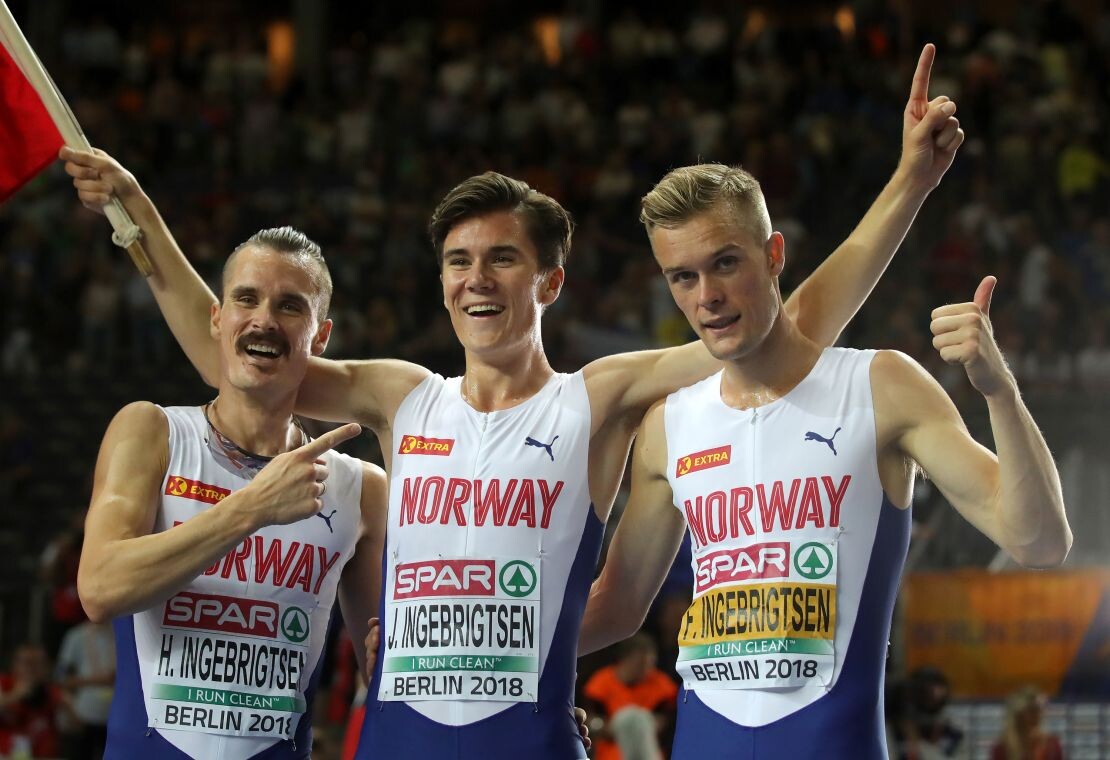
The Making of Champions
Gjert Ingebrigtsen approached coaching with a scientific precision, designing rigorous training plans that tested the physical and mental boundaries of his sons. From a young age, Jakob, Henrik, and Filip were subjected to high-pressure environments that demanded discipline and focus far beyond what most young athletes experience. This relentless drive for perfection produced remarkable results:
Jakob Ingebrigtsen, the youngest of the brothers, is the reigning Olympic champion in the 1500m (2020 Tokyo) and the 5000m (2024 Paris). He also holds world records in events ranging from the 2000m to the two-mile distance.

Henrik and Filip have also claimed European titles and made their mark in global competitions, showcasing the strength of Gjert’s training philosophy.
Central to Gjert’s success was his ability to push his sons far outside their comfort zones, a critical skill in elite racing where discomfort is inevitable. Jakob’s fearless racing style, where he often dictates the pace from the front, exemplifies the mental toughness forged under his father’s guidance.
The Cost of Greatness
While Gjert’s methods undeniably built champions, they also came at a significant emotional cost. In October 2023, the brothers publicly accused their father of aggression, control, and physical violence during their upbringing and training. Gjert has denied these allegations, but the legal case and its impact on the family dynamic have cast a shadow over their achievements.
Jakob and his brothers have spoken about the challenges of growing up in a high-pressure environment. The emotional strain, coupled with Gjert’s demanding expectations, led to a complex relationship between father and sons. While the discipline and mental resilience instilled by Gjert have undoubtedly contributed to their success, the allegations highlight the fine line between rigorous coaching and harmful behavior.
Jakob’s Success Amid Adversity
Despite the personal challenges, Jakob continues to dominate the global stage. In 2024, he won his second Olympic gold in the 5000m at the Paris Games, further cementing his legacy as one of the greatest distance runners of all time. His ability to consistently perform under pressure reflects not only his physical talent but also the mental toughness cultivated during his father’s intensive coaching.
Jakob’s racing style—marked by a willingness to embrace discomfort and push beyond limits—bears the hallmark of Gjert’s philosophy. However, as he and his brothers navigate their careers independently, they are forging their own paths while acknowledging the dual impact of their father’s legacy.
A Complicated Legacy
Gjert Ingebrigtsen’s role in his sons’ success cannot be overstated. His unrelenting pursuit of excellence shaped them into some of the most formidable athletes in the history of middle-distance running. Yet, the recent revelations remind us that behind every champion is a story of sacrifice, struggle, and, sometimes, pain.
The Ingebrigtsen family’s journey raises important questions about the balance between ambition and well-being. While Gjert’s methods produced results that few could argue with, they also left scars that the brothers are now working to heal. Their story serves as both an inspiration and a cautionary tale about the cost of greatness.
As Jakob continues to inspire the running world with his performances, the legacy of Gjert’s coaching will remain a defining, if complicated, part of the Ingebrigtsen story.
(01/27/2025) ⚡AMPby Boris Baron
Cameron Myers Shatters World U20 Indoor Mile Record with 3:53.12 Victory in New York
Eighteen-year-old Australian sensation Cameron Myers has rewritten history books, taking nearly two seconds off the world U20 indoor mile record with a stunning 3:53.12 victory at the Dr. Sander Invitational in New York on Saturday Jan 25.
Competing in his first-ever indoor race, Myers showcased exceptional poise and talent, holding off fierce competition from Kenya’s Festus Lagat and Britain’s Adam Fogg to secure the win at the World Athletics Indoor Tour Bronze meeting.

The race was a test of both speed and strategy. Myers maintained a calculated pace through the early laps before unleashing his signature finishing kick, edging Lagat by 0.37 seconds. Lagat crossed the line in 3:53.49, while Fogg took third with 3:53.86.
Myers’ groundbreaking performance obliterated the previous world U20 indoor mile record of 3:55.02, set by USA’s German Fernandez in 2009. Moreover, his 1500m split of 3:37.89 set a new Oceanian U20 indoor record, adding another accolade to his already glittering resume. The milestone places him eighth on the Oceanian senior all-time indoor list, trailing only legendary figures like 1976 Olympic 1500m champion John Walker.
A Rising Star of Middle-Distance Running

This latest achievement adds to an impressive string of records for Myers, who has consistently demonstrated his dominance on the track. Outdoors, he has set numerous continental age-group records, including a jaw-dropping 3:33.26 for 1500m, a 3:50.15 mile, and a 7:41.11 over 3000m achieved just last month. These feats have established him as one of the brightest young talents in global athletics.
Myers’ victory in New York marks a significant step forward in his career and hints at even greater potential in the years to come. Speaking after the race, the young star reflected on his achievement: "This was my first indoor race, so I wanted to approach it with focus and determination. Breaking the record is surreal, but it’s just the beginning."
A Glimpse into the Future
With his eyes set on continued success, Myers has proven he can compete with the best in the world. His ability to excel across different distances and surfaces underscores his versatility and determination to reach the top of the sport. At just 18 years old, Myers has not only etched his name in the record books but also inspired a new generation of athletes to dream big.
As the track and field world celebrates this remarkable milestone, all eyes will be on Cameron Myers as he continues to push boundaries and set new standards in middle-distance running.
(01/27/2025) ⚡AMPby Boris Baron
The Indian Running Sensation Making Strides Without Shoes
If you have not heard of Barefoot Bobby yet, it's time to take notice. The 58-year-old runner from Bangalore, India, has captured the imagination of the running world with his unconventional yet inspiring approach to the sport of running entirely barefoot. Bobby's remarkable journey reached a new milestone last Sunday at the 2024 Mumbai Marathon, where he clocked one of the fastest times of his career, finishing in 3:11:47. His incredible performance earned him third place in the competitive men's 55-59 age group.
Bobby, whose real name is Ramesh Patel, began running barefoot nearly 30 years ago, initially as a practical choice due to a lack of access to proper running shoes. Over time, what started as a necessity became his signature style. Running without shoes, Bobby says, keeps him connected to the ground and allows him to feel every stride more naturally.
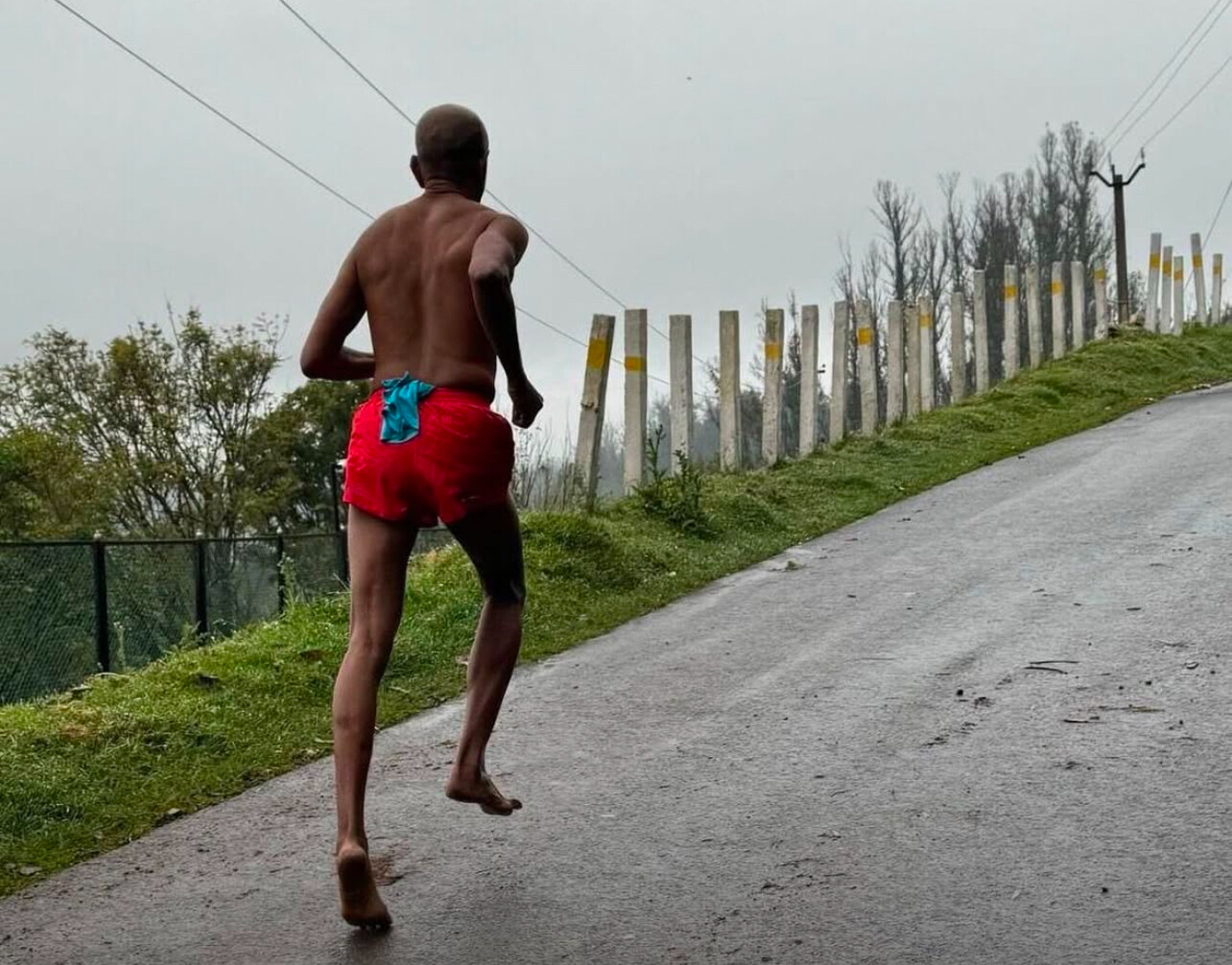
At the Mumbai Marathon, Bobby's effortless stride and unyielding pace drew cheers from spectators along the route. His 3:11:47 finish wasn’t just a personal achievement; it was a testament to his resilience and the strength of his training, which includes long runs on Bangalore's rugged trails.
"I've always believed that running barefoot is a way to honor the simplicity of the sport," Bobby shared after the race. "The road doesn't care if you wear the latest gear or go barefoot. What matters is your passion and dedication."

Bobby's story has inspired runners worldwide, proving that innovation and tradition can coexist on the marathon course. At 58, he shows no signs of slowing down, and his sights are set on breaking the 3-hour barrier in the coming years.
Barefoot Bobby's journey reminds us all that running is about more than just physical performance is about heart, determination, and embracing your unique path.
(01/26/2025) ⚡AMP
by Boris Baron
Remembering James Lightbody: The Middle-Distance Maestro of the Early 20th Century
James Lightbody, one of the most remarkable middle-distance runners of his time, left an indelible mark on Olympic history. A dominant force at the 1904
Summer Olympics, Lightbody secured three gold medals in the 800m, 1500m, and the 2,590m steeplechase. His winning time of 4:05.4 in the 1500m was recognized as a world record, although it lagged behind Tom Conneff's amateur mile record of 4:15.6, set years earlier.

Beyond the 1904 Games, Lightbody continued to showcase his prowess. In 1905, he achieved a double victory in the 880-yard and mile events at the AAU Championships.

At the 1906 Intercalated Games, he successfully defended his Olympic 1500m title and earned a silver medal in the 800m.
However, his 1908 Olympic campaign in London was less successful, as he was eliminated in the heats of the 800m, 1500m, and steeplechase.
A graduate of the University of Chicago, Lightbody represented the Chicago Athletic Association during his competitive years.
After his Olympic career, he moved to Berlin where he became the German champion in the 800m and 1500m in both 1910 and 1911.
Personal Bests
400m: 53.0 (1906)
800m: 1:56.0 (1904)
1500m: 4:05.4 (1904)
Olympic Achievements
1904 Summer Olympics
800m: Gold
1500m: Gold
2,590m Steeplechase: Gold
4-Mile Team: Silver
1906 Intercalated Games
800m: Silver
1500m: Gold
1908 Summer Olympics
Competed in 800m, 1500m, and 3,200m steeplechase (eliminated in heats)
James Lightbody's achievements cement his legacy as a pioneer in middle-distance running, inspiring generations of athletes to follow in his footsteps.
(01/26/2025) ⚡AMPby Boris Baron
Sheila Avilés Castaño Lives for Peaks and Nature
Sheila Avilés Castaño, born on July 7, 1993, in Santa Margarida de Montbui, Spain, is a trail and skyrunning athlete whose passion for nature and sport has propelled her to remarkable achievements on the global stage. From a young age, Sheila found joy in the outdoors, combining her athletic talent with her love for the mountains. Trail running became her sanctuary, offering the perfect balance between physical challenge and the beauty of nature.
Over the years, Sheila has built an impressive career, winning major titles and captivating fans around the world. In 2017, she claimed the Sky Classic category of the Skyrunning World Cup and earned a bronze medal at the European Skyrunning Championships. Two years later, she added another Skyrunning World Cup title to her name, proving her consistency and determination at the highest level of competition. Her crowning achievement came in 2022 when she triumphed at the OCC race of the UTMB Mont-Blanc, a victory that cemented her status as one of the top athletes in her discipline.

In 2024, Shella continued to showcase her extraordinary talent and resilience. At the HOKA Val d'Aran by UTMB®, she completed the 18 km course with 465 meters of elevation gain in 1:32:07, placing 3rd among women. Later in the year, she dominated the adidas TERREX INFINITE TRAILS 30K Individual race, finishing in 3:25:08 and securing 1st place in the women's category.

She also put in a strong performance at the Salomon Ultra Pirineu's Mitja Pirineu 21k, covering the challenging 21 km course with 1,200 meters of elevation gain in 1:50:05, finishing 6th among women. Her consistency across diverse events reflects her adaptability and unwavering commitment to the sport.
Beyond her racing accomplishments, Sheila is an ambassador for the beauty of trail running and the deep connection it fosters with nature. Through her social media and public appearances, she inspires runners and outdoor enthusiasts worldwide to embrace the mountains and push their limits.
For Sheila, running is more than a sport-it's a way of life, a celebration of the human spirit, and a testament to what can be achieved with passion and dedication.
Sheila Avilés Castaño continues to conquer peaks and inspire others, reminding the world that no summit is too high when approached with determination and love for the journey.
(01/26/2025) ⚡AMPThe Evolution of My Pre-Run Nutrition
For many years, I believed that running on an empty stomach was ideal. I focused primarily on my meal the night before, opting for light, meatless dishes. However, around 1999, I began eating half a banana before races and noticed improved performances.
By 2000, my pre-race dinner evolved to include a fully loaded baked potato, steamed broccoli, and a six-ounce piece of lean meat. On race mornings, I continued with just half a banana. This change provided sustained energy, especially for races over 5K.

A memorable experience was the 2013 Boston Marathon. My son and I had pancakes before the race, which started later in the day. Along with five energy gels and Gatorade at every other mile, this fueling strategy helped me finish in 3:32:17 at age 65, starting from the back and passing thousands of runners.

Since turning 70, I have made it a habit to eat something about an hour before running. My go-to is half an English muffin with cream cheese. This morning, Catherine prepared avocado toast, which, though more substantial than usual, worked well.
In conclusion, I have found that consuming a light meal or snack an hour or two before running enhances performance and energy levels. It is essential to find what works best for you through personal experimentation.
Insights from others on Pre-Run Nutrition
My personal experiences align with broader recommendations from nutrition experts. Consuming carbohydrates before a run is crucial, as they serve as the body's primary energy source. Registered dietitian Brenna Larson emphasizes that eating before a workout helps maintain stable blood sugar levels, supports muscle endurance, and promotes faster recovery. She suggests having a meal 2 to 3 hours before exercise or a carbohydrate-rich snack 30 to 60 minutes prior for quick energy.
Ideal pre-run foods include a mix of carbs and protein, such as fruit with peanut butter, Greek yogurt with honey, dried fruit and nuts, oatmeal with banana, or berry smoothies with nut butter. These combinations provide essential nutrients to sustain energy and aid muscle repair.
It is also important to avoid high-fat, high-fiber foods, and large meals right before running to prevent digestive issues. Finding the right diet requires personal experimentation, and keeping a food journal can help optimize performance and comfort.
(01/26/2025) ⚡AMP
by Bob Anderson
Edesa retains marathon title in Osaka
Ethiopia’s Workenesh Edesa successfully defended her title at the Osaka Women’s Marathon, a World Athletics Platinum Label road race, on Sunday (26).
The course record-holder, who ran 2:18:51 when winning last year, this time clocked 2:21:00 to take top spot ahead of Japan’s Kana Kobayashi and Yuka Suzuki, who both ran big PBs.
Seven runners joined the pacemakers in covering the first 5km in 16:50 and they passed 10km in 33:23.
Japan’s Mizuki Matsuda and Natsumi Matsushita plus Israel’s Lonah Chemtai Salpeter started to fall behind after 12km. Edesa, Kobayashi, Suzuki and Japan’s Nanaka Izawa, who was making her marathon debut, remained together, passing 15km in 50:02 and 20km in 1:06:32.
Kobayashi fell behind after 21km, only to regain contact a few kilometres later, but she was dropped again, leaving Edesa, Suzuki and Izawa to pass the 25km mark in the lead in 1:22:53.
Izawa was next to go, and by 28km Suzuki was also gone from the lead pack. Edesa passed 30km alone in 1:56:06, 17 seconds ahead of Suzuki, with Kobayashi another 34 seconds back.
Edesa continued to run solo, passing 40km in 2:13:26. Suzuki was 18 seconds behind, but Kobayashi was closing the gap and was 16 seconds behind Suzuki at that point.
Edesa’s victory was never in doubt and she won in 2:21:00, while Kobayashi passed Suzuki with 800m to go to move into second place. Suzuki couldn’t respond and so Kobayashi secured the runner-up spot in 2:21:19, improving on her previous PB of 2:24:59, while Suzuki was third in 2:21:33, improving her own previous best of 2:24:02.
Paris Olympic ninth-place finisher Salpeter, who was the fastest in the field thanks to her PB of 2:17:45 set in Tokyo in 2020, clocked 2:24:03 to finish fourth, while Matsushita was fifth in 2:26:04.
“I am happy to defend the title from 2024,” said Edesa. “My goal is to further improve my personal best.”
Kobayashi said: “It hasn't dawned on me yet. My goal was to clinch the World Championships marathon team berth by running 2:23. I am surprised to perform this well. Fans along the route encouraged me by saying the leaders were slowing down, which gave me a power to push on.”
With thanks to Ken Nakamura
Leading results
1 Workenesh Edesa (ETH) 2:21:002 Kana Kobayashi (JPN) 2:21:19 3 Yuka Suzuki (JPN) 2:21:33 4 Lonah Chemtai Salpeter (ISR) 2:24:035 Natsumi Matsushita (JPN) 2:26:046 Chiharu Suzuki (JPN) 2:26:417 Mizuki Matsuda (JPN) 2:27:11 8 Nanaka Izawa (JPN) 2:29:28
(01/26/2025) ⚡AMPCelebrating Steve Prefontaine: A Legend Who Inspires Generations
January 25 marked what would have been Steve Prefontaine's 74th birthday. Though his life ended far too soon in 1975, his legacy of passion, resilience, and determination continues to burn brightly. Known not only for his remarkable achievements on the track but also for his unwavering spirit, Prefontaine embodied a relentless pursuit of excellence that transcended the world of running.
Pre as he was affectionately called, left an indelible mark not just on the sport of Track and Field but on the hearts of people from all walks of life. His drive to push limits and his commitment to living boldly have inspired countless individuals to dream bigger and strive harder in their own endeavors. Whether it was his gutsy performances in competition or his belief that effort defines success, Prefontaine's story continues to ignite passion and determination worldwide.

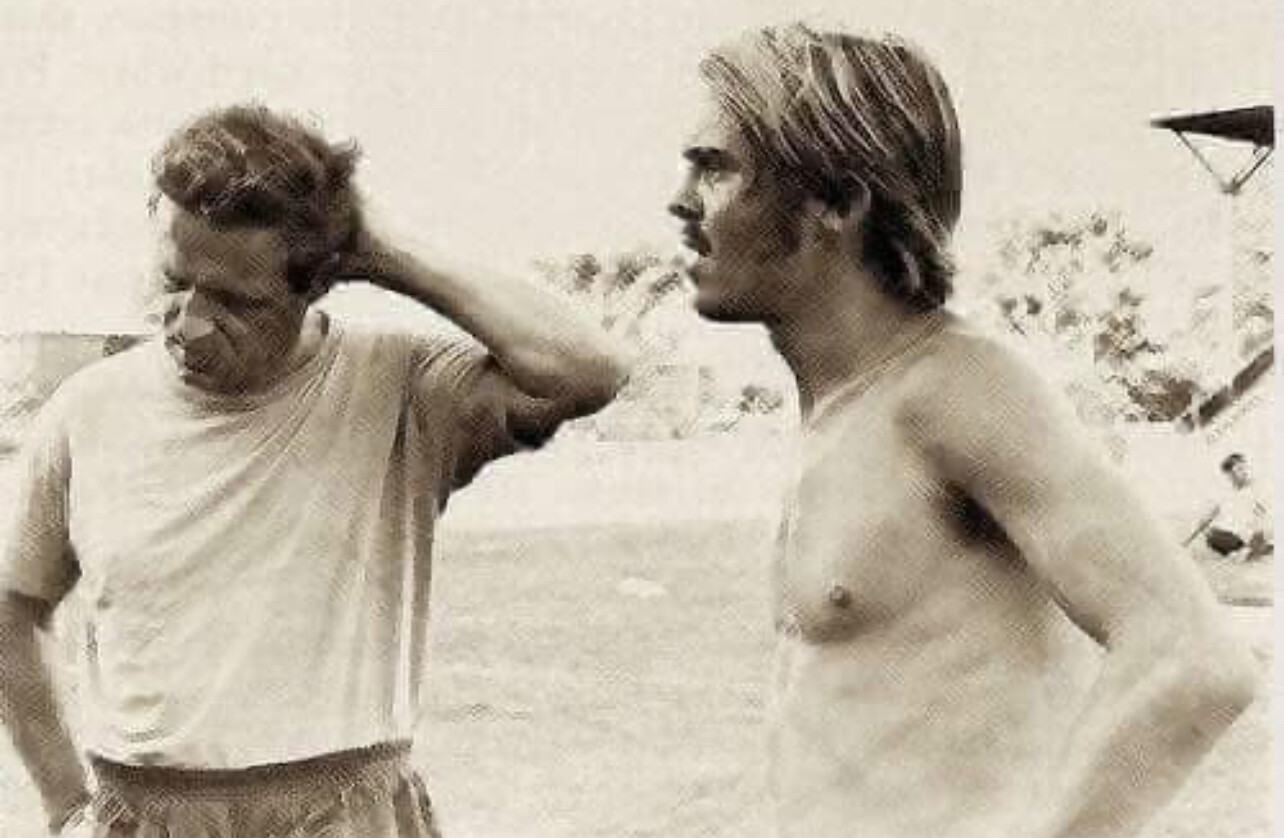
Though his earthly years were brief, Steve's influence reaches far beyond his time. His legend is a timeless reminder that greatness is achieved not just through talent but through an unyielding spirit and an uncompromising will to succeed.
Happy Birthday, Pre. Your legacy lives on. Go Pre!
(01/25/2025) ⚡AMP
by Boris Baron
The Power of Miles: Mixing Walking and Running at Any Age
Since turning 70 seven years ago, I have embraced walking as a key part of my routine. Recently, walking has made up 80% of my weekly mileage. I am just coming off a situation with a tendon in my calf, as I mentioned in my first column, and I'll be increasing my running back up to 50%. I like this ratio better, and on Sundays, when I am not in Portugal at our place there, my friend JR and I are focused on getting our 10K pace back down to sub-9 minutes per mile or even sub-8:30.
I also like to get in miles with others. While in Portugal, most Sundays I get together with two to six people, and we walk (sometimes mixing in some running) to the next village 7.4 miles away. If we only walk, it takes over two hours, but it is so rewarding. Not only do we get in the miles, but we also enjoy non-stop conversations about everything. It's a great way to stay active and connect with others at the same time.

Looking back, I wish I had added walking to my schedule when I was younger. In my 50s, I was running 42 miles weekly, mostly quality miles, and racing well, often at a sub-6-minute pace. But on hindsight, I think incorporating two miles or so of walking daily would have helped. Those miles could have been added during daily activities, much like I do now. I never drive to lunch, I walk, run, or do a mix of both. I add miles whenever I can.
If I am getting tires for the car, I don't sit in the lobby; I get out the door for a walk or a walk/run. I think you get the picture: I make it a habit to fit in miles whenever possible, and I count those miles as part of my regular workouts.
Thinking back to those days, I was also hiking with my wife Catherine. Sometimes we were out for three hours. I did not clock those miles back then, but on hindsight, I believe that walking, especially those hikes, played a role in helping me run some decent times.
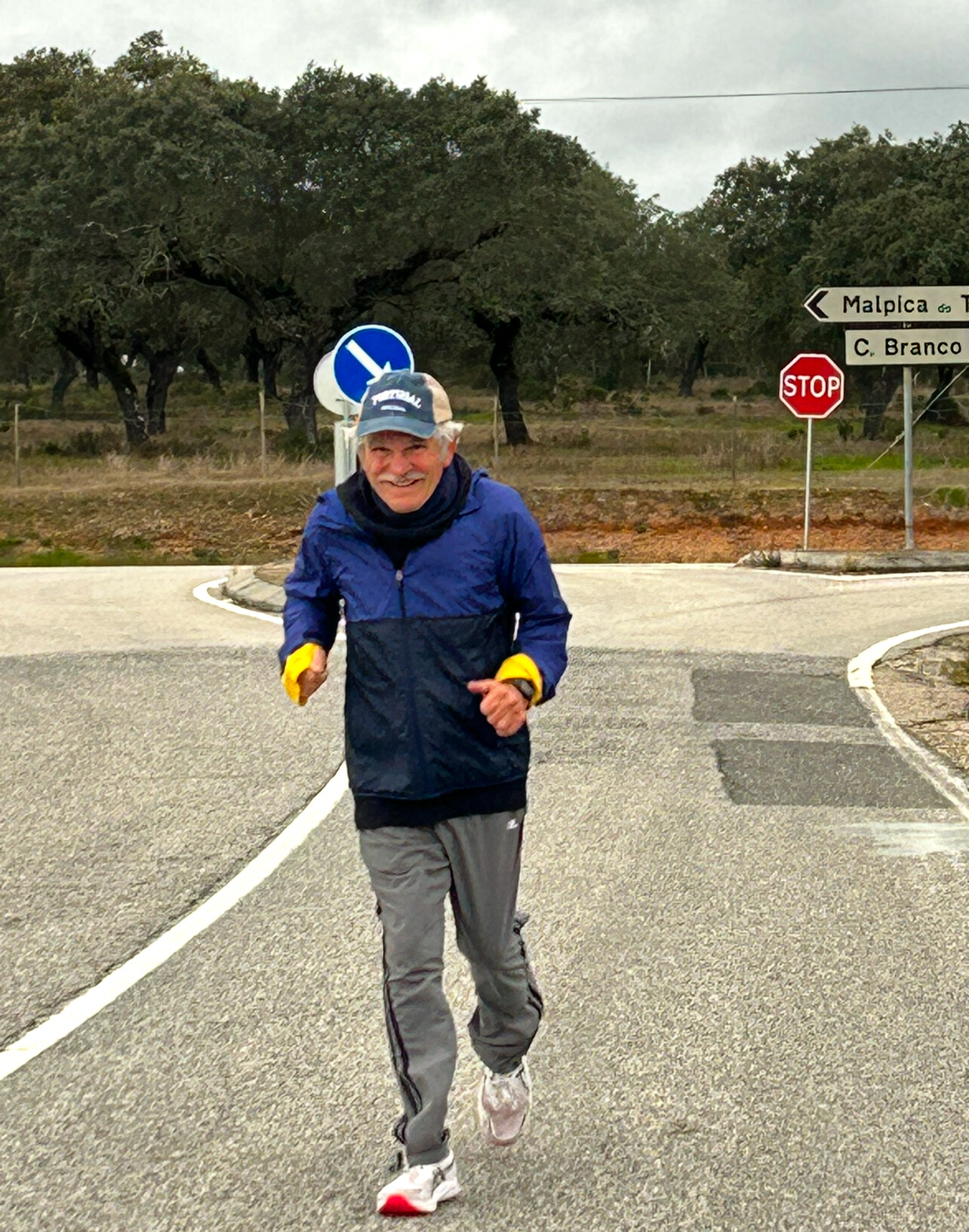
Since July 2018, my weekly average has been 44 miles, totaling over 16,400 miles. While my mileage has dropped a bit in the past year due to 12 trips to Portugal, each trip costing me about four low-mileage days, I remain committed to staying active.
Walking is valuable, but it is not a substitute for running if your goal is to train for running. To run at a good pace, you need to put in the work running. However, walking gets you outside, keeps you moving, and can serve as a recovery tool or a way to maintain consistency when running is not an option. At any age, especially at 77, movement matters.
Walking does take at least twice the time to cover the same distance as running, so I often incorporate strides to add variety and keep things interesting. For example, I will count to 50 or 100 strides, pick up the pace, then return to walking. It is a simple way to stay engaged while adding a little extra effort.
Mixing walking and running has been a game-changer for me. Running challenges my endurance and keeps me sharp, while walking allows me to recover, reflect, and enjoy the journey. Whether you are walking, running, or a mix of both, every mile tells a story of persistence, progress, and the joy of staying active. Movement matters it is that simple.
Photos: walking and running in Monforte da Beira Portugal recently from our Anderson Manor and home for KATA Portugal
(01/25/2025) ⚡AMP
by Bob Anderson
Josh Kerr Signs Long-Term Deal with Brooks Ahead of 2025 Track Season
British middle-distance star Josh Kerr has solidified his place as a key figure in the world of athletics by announcing a long-term partnership with the $1.2 billion sportswear brand, Brooks. The 2023 World Champion in the 1500m continues to demonstrate his commitment to excellence as he gears up for the 2025 track season.
Kerr’s relationship with Brooks dates back to 2018, when the then-NCAA champion decided to forgo his remaining collegiate eligibility at the University of New Mexico to pursue a professional running career. The decision proved to be pivotal, as Kerr’s career flourished under the Brooks Beasts Track Club, where he became a standout figure on the global stage.
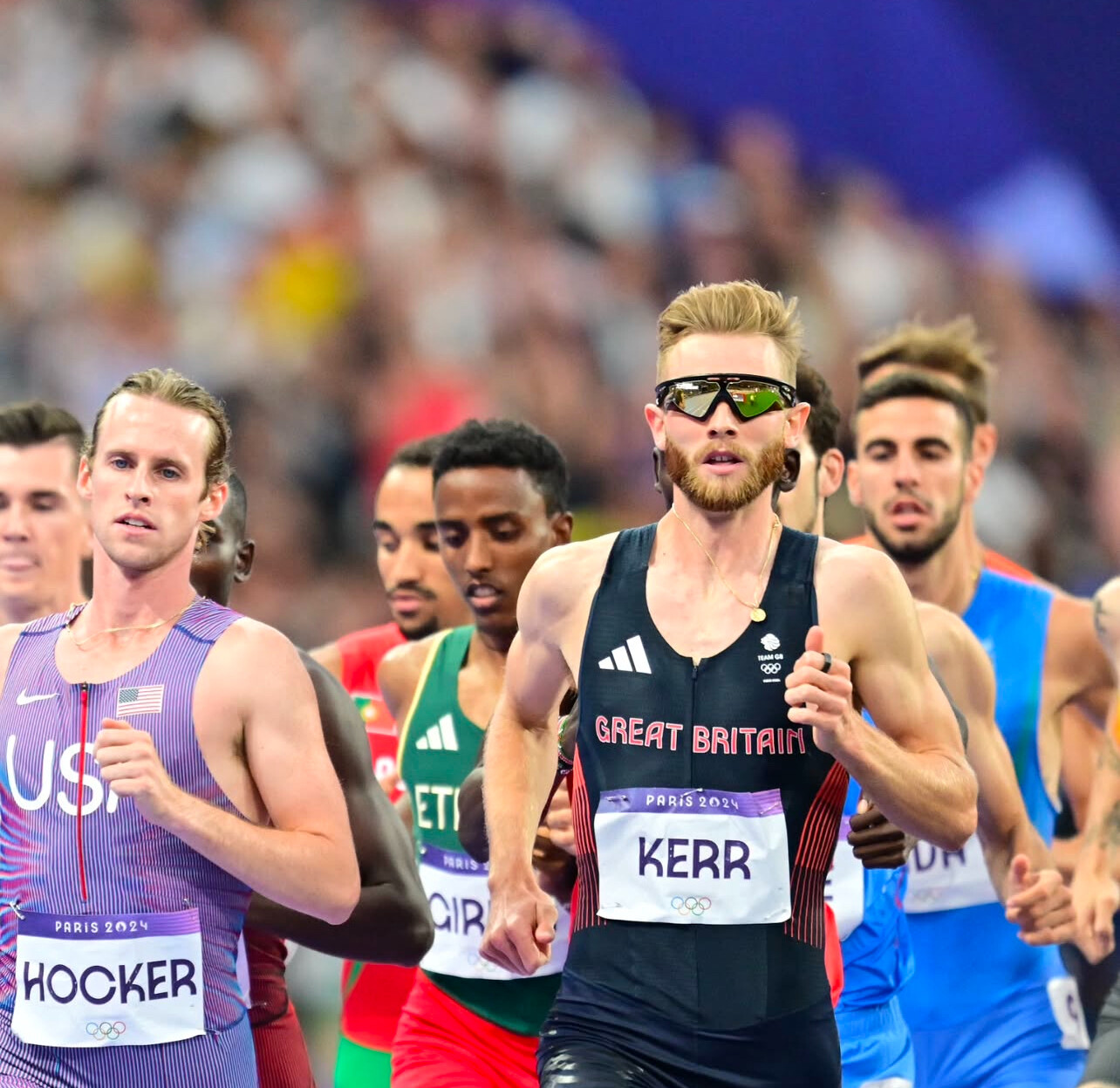
Since turning professional, Kerr has achieved numerous accolades, including his iconic bronze medal performance in the 1500m at the Tokyo 2020 Olympics and his dominant gold medal run at the 2023 World Athletics Championships in Budapest. Most recently, Kerr delivered a sensational performance at the Paris 2024 Olympics, where he claimed the gold medal in the 1500m, solidifying his reputation as one of the all-time greats in middle-distance running.
These achievements have cemented his status as one of the finest middle-distance runners of his generation. His journey from NCAA champion to global icon is a testament to his talent, determination, and the strong support system provided by Brooks.
Kerr’s partnership with Brooks goes beyond performance gear; it reflects a shared vision of inspiring the next generation of athletes. As he continues to compete at the highest level, his role as a brand ambassador for Brooks highlights the company’s dedication to supporting world-class talent and pushing the boundaries of innovation in running.

"I’m excited to announce my commitment to a long-term partnership with this incredible brand. Working alongside such a talented team of coaches and athletes has not only helped me become the athlete I’ve always aspired to be but also allowed us to create the best gear to elevate performance. I’m pumped for the journey ahead and the continued success we’ll achieve together," he wrote.
With the 2025 track season on the horizon, Kerr’s renewed partnership positions him to build on his remarkable career and take on new challenges. Fans and competitors alike will eagerly watch as the Scottish athlete, now one of the most recognizable faces in middle-distance running, seeks to leave an even greater mark on the sport.
(01/25/2025) ⚡AMP
by Boris Baron
Progressive Step-Up Training: Unlocking Speed and Endurance
Progressive Step-Up Training is a method Bob Anderson has championed for over 20 years. It’s a simple yet powerful technique designed to progressively increase speed, either through track intervals or on long road runs. The goal? To finish faster than you started, building confidence and strength for peak race performance.
Here’s how it works: each mile (or kilometer) in the workout must be faster than the one before. The mental and physical challenge lies in maintaining focus and pacing while overcoming the pressure to perform with each step-up.

A Real-World Example
In preparation for the Stockton 10-Mile Race on January 7, 2001, Bob used the Progressive Step-Up method as a cornerstone of his training. Leading up to the race, he dedicated one day per week to a Progressive Step-Up session, alongside two long runs. On average, he logged 42 miles weekly.
During a December track session at Foothill College, Bob completed a 6x1-mile Progressive Step-Up workout:

First Mile: 5:47
Second Mile: 5:42
Third Mile: 5:36
Fourth Mile: 5:27
Fifth Mile: 5:21
Sixth Mile: 5:17
Each interval demanded more effort, pushing both physical and mental boundaries. The break can be up to five minutes or when you are ready to run faster. By the final mile, Bob had surpassed his expectations, proving to himself he was ready to take on the race.
“I believe the most important part of my training was the Progressive Step-Up,” Bob reflects. “It taught me to stay focused, handle increasing pressure, and finish strong.”
The Race
At 53 years old, Bob’s goal for the Stockton 10-Mile Race was to break 60 minutes. Thanks to his progressive training, he hit the ground running, clocking:
Mile 1: 5:37
Mile 2: 11:15
Mile 3: 17:00
Mile 6: 34:50
Despite feeling fatigued by mile 7, the foundation built through the Progressive Step-Up method allowed Bob to finish strong, crossing the line in 59:17, his last mile being 5:57,
Why It Works
Progressive Step-Up Training develops both physical strength and mental resilience. It teaches athletes to handle increasing pressure and fatigue while maintaining focus on their goals. The flexibility of the method allows for adaptation to different distances, making it ideal for runners of all levels.
Applying It to Your Training
Choose Your Format: Decide between track intervals or a long road run.
Start Controlled: Begin at a manageable pace, focusing on proper form and rhythm.
Increase Incrementally: With each mile or repetition, push yourself slightly harder, aiming for a faster time.
Rest as Needed: Take sufficient recovery time to ensure quality when doing intervals. On long runs just keep pushing the pace for each mile.
Finish Strong: Challenge yourself to make the final repetition or mile your fastest.
Whether preparing for a race or building fitness, Progressive Step-Up Training can help you unlock your potential. Just as it did for Bob Anderson in 2001, this approach can sharpen your mind, strengthen your body, and give you the confidence to achieve your goals.
Bob and his wife, Catherine, have established two world-class training camps to help runners reach their full potential: KATA Kenya and KATA Portugal. Join us to train the Kenyan way and take your running to the next level. Kenyan Athletics Training Academy.
Learn more at: https://katarunningretreat.com/
All photos taken during 2012 when Bob ran 50 races covering 350.8 miles and average 6:59 per mile. This feat was featured in the movie A Long Run the movie.
(01/24/2025) ⚡AMPby Boris Baron
Kebede, Kipruto, Kosgei and Cheptegei announced for Tokyo Marathon
Sutume Kebede and Benson Kipruto will defend their titles when they form part of strong fields announced for the Tokyo Marathon – a World Athletics Platinum Label road race – on 2 March.
Ethiopia’s Kebede, who set a Japanese all-comers' record of 2:15:55 when winning in Tokyo last year, is set to be joined by five other women to have dipped under 2:18 in a field that features a total of 11 sub-2:20 runners.
Two of them are also formers winners, with Brigid Kosgei and Rosemary Wanjiru returning after their respective victories in 2022 and 2023.
Kenya’s former world record-holder Kosgei is the fastest in the field with her PB of 2:14:04 set in Chicago in 2019, while her compatriot Wanjiru ran 2:16:14 when finishing runner-up to Kebede in Tokyo last year.
Among those joining them are Ethiopia’s Tigist Ketema, who ran 2:16:07 on her debut in Dubai just over a year ago, and multiple global gold medallist Tirunesh Dibaba.
Their compatriots Hawi Feysa, who won in Frankfurt in October in 2:17:25, 2022 world champion Gotytom Gebreslase and 2021 London Marathon runner-up Degitu Azimeraw have also been announced, along with Japan’s Ai Hosoda and Yuka Ando.
Kenya’s Kipruto, who also set a Japanese all-comers' record when winning in Tokyo last year in 2:02:16, will be joined in the men’s race by Uganda’s Joshua Cheptegei, the world 5000m and 10,000m record-holder who returns to the roads to contest his second marathon after his 2:08:59 debut in Valencia in 2023.
The field features six sub-2:04 athletes, with Kipruto joined by Ethiopia’s Deresa Geleta, the Olympic fifth-place finisher and Valencia Marathon runner-up who has a best of 2:02:38, plus two-time Tokyo Marathon winner Birhanu Legese, Tadese Takele and Dawit Wolde, as well as Kenya’s Vincent Kipkemoi Ngetich, who was third last year.
The line-up also includes Ethiopia’s world bronze medallist Leul Gebresilase, Uganda’s Stephen Kissa, Japan’s Yohei Ikeda and Akira Akasaki, and Kenya’s Benard Koech, who makes his marathon debut.
Elite fields
WomenBrigid Kosgei (KEN) 2:14:04Sutume Kebede (ETH) 2:15:55Tigist Ketema (ETH) 2:16:07Rosemary Wanjiru (KEN) 2:16:14Hawi Feysa (ETH) 2:17:25Tirunesh Dibaba (ETH) 2:17:56Degitu Azimeraw (ETH) 2:17:58Gotytom Gebreslase (ETH) 2:18:11Winfridah Moraa Moseti (KEN) 2:18:25Mestawut Fikir (ETH) 2:18:48Magdalyne Masai (KEN) 2:18:58Ai Hosoda (JPN) 2:20:31Desi Jisa Mokonin (BRN) 2:20:47Yuka Ando (JPN) 2:21:18Jessica Stenson (AUS) 2:24:01Zhang Deshun (CHN) 2:24:05Rie Kawauchi (JPN) 2:25:35Kaori Morita (JPN) 2:26:31Khishigsaikhan Galbadrakh (MGL) 2:26:32Shiho Kaneshige (JPN) 2:28:51
MenBenson Kipruto (KEN) 2:02:16Deresa Geleta (ETH) 2:02:38Birhanu Legese (ETH) 2:02:48Vincent Kipkemoi Ngetich (KEN) 2:03:13Tadese Takele (ETH) 2:03:24Dawit Wolde (ETH) 2:03:48Leul Gebresilase (ETH) 2:04:02Stephen Kissa (UGA) 2:04:48Tsegaye Getachew (ETH) 2:04:49Amedework Walelegn (ETH) 2:04:50Titus Kipruto (KEN) 2:04:54Yohei Ikeda (JPN) 2:05:12Suguru Osako (JPN) 2:05:29Mulugeta Asefa Uma (ETH) 2:05:33Ichitaka Yamashita (JPN) 2:05:51Kenya Sonota (JPN) 2:05:59Hiroto Inoue (JPN) 2:06:47He Jie (CHN) 2:06:57Vincent Raimoi (KEN) 2:07:01Hendrik Pfeiffer (GER) 2:07:14Akira Akasaki (JPN) 2:07:32Suldan Hassan (SWE) 2:07:36Joshua Cheptegei (UGA) 2:08:59Benard Koech (KEN) debutGeoffrey Toroitich (KEN) debut
(01/23/2025) ⚡AMPEmbracing Challenges as "Situations" in a Lifetime of Running
Bob Anderson laced up his running shoes for the first time on February 16, 1962, setting in motion a journey that has spanned over six decades. Now 77 years old, Bob continues to average 35 miles a week, a combination of running and walking split between his homes in Los Altos, California, and Monforte da Beira, Portugal.
Beyond his personal fitness, Bob is the founder of KATA Running Retreat in Portugal (and KATA Kenya), where runners from around the world train under the guidance of accredited Kenyan coaches, learning the art of running the Kenyan way.

For Bob, running is not just an activity—it’s a way of life. Yet, like any long-term runner, he has faced his share of physical setbacks. What makes Bob's perspective unique is how he approaches these challenges. He refuses to call them "injuries." Instead, he reframes them as "situations," each with its own solution.
Turning Challenges into Opportunities
“I feel it’s more positive to see problems as situations,” Bob explains. “Every situation has a solution. It’s about finding it and moving forward.”
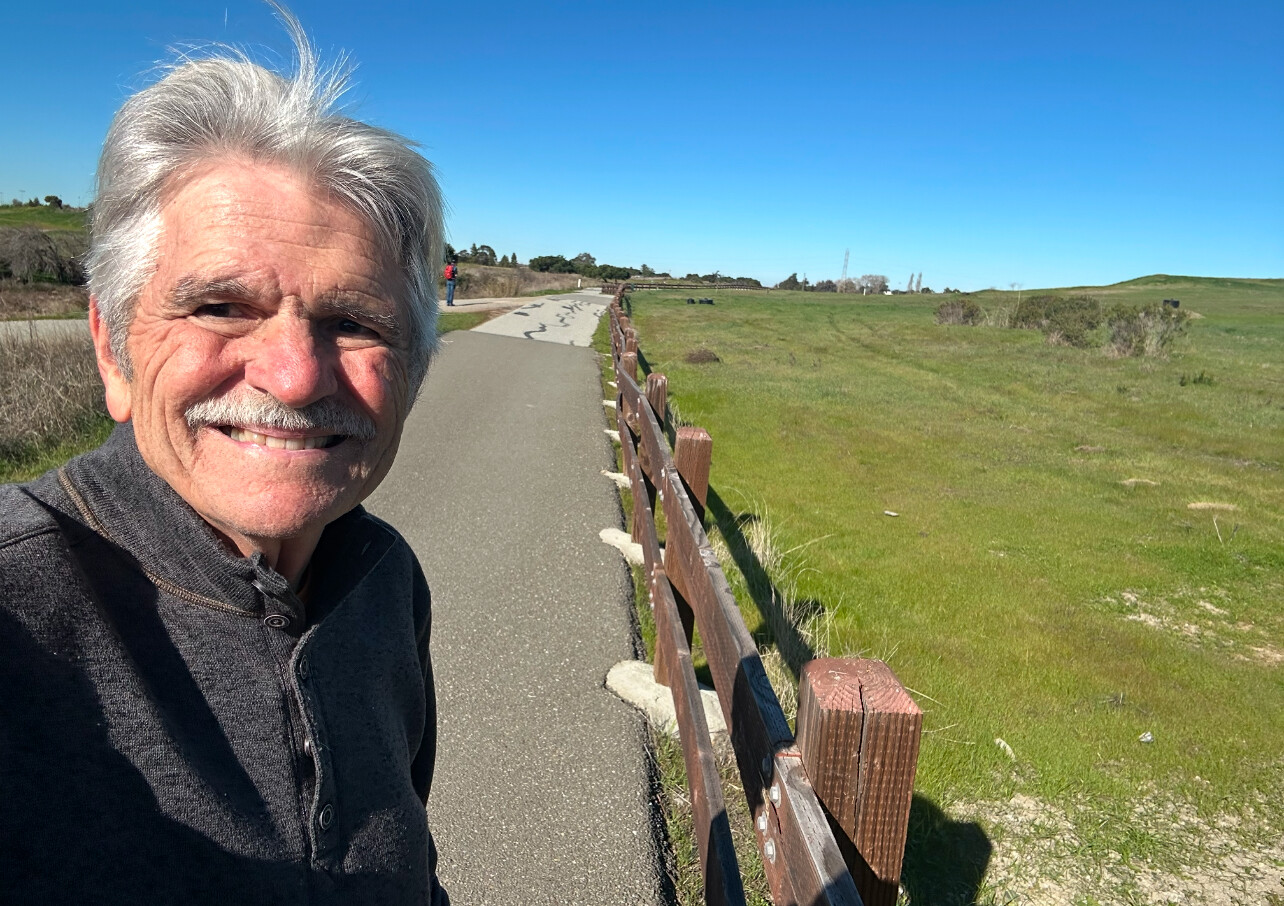
This mindset has carried Bob through countless running-related issues over the years. Most recently, he encountered a tendon situation in his right calf, which he describes as feeling like “an ice pick stuck in my calf.” For many, such a setback could mean frustration or discouragement. For Bob, it was simply another situation to navigate.
The calf issue emerged six weeks ago, temporarily sidelining him from running. “At one point, I could only walk a 32-minute mile,” he recalls. “It was a low point, but I knew I just had to focus on walking instead of running. The solution was to keep moving, even if it wasn’t at the pace I wanted.”
Today, Bob is on the cusp of full recovery. The pain has subsided, and he’s back to building his strength and endurance. “Now, I have to get in shape to get in shape,” he says. It’s a sentiment that many runners recovering from setbacks can relate to: the road back to peak performance often starts with small, deliberate steps.
A Lifetime of Solutions
Over the decades, Bob has faced numerous "situations," from shin splints to plantar fasciitis, and even the natural slowing of pace that comes with age. Yet his ability to adapt, learn, and persevere has kept him running—and walking—well into his 70s. Adding walking to his routine has not only helped him stay active through setbacks but has also introduced a new dimension to his training.
“Walking isn’t just a fallback,” Bob says. “It’s a powerful way to stay connected to the movement and keep your body engaged, even when running isn’t possible.”
Inspiring Others Through KATA
Bob’s passion for running extends beyond his personal journey. At KATA Running Retreat in Portugal, he shares his wisdom with runners of all levels. The retreat offers a chance to train with world-class Kenyan coaches, combining the cultural richness of Portuguese countryside with the legendary endurance techniques of Kenya.
“KATA is about helping runners achieve their personal best,” Bob says. “Whether it’s overcoming a situation, improving your times, or learning to enjoy the process, we’re here to support every step of the journey.”
Moving Forward with Optimism
As Bob continues to recover from his latest situation, he remains optimistic. His story is a testament to the power of resilience, adaptability, and a positive mindset. For him, running is not just about miles or pace—it’s about the journey and the lessons learned along the way.
“At the end of the day, it’s not about being perfect,” Bob reflects. “It’s about showing up, finding solutions, and keeping your passion alive.”
For Bob Anderson, every mile—whether walked or run—is a victory. And every situation is just another step toward the next solution.
The Legacy of KATA
Bob’s vision for running has extended far beyond himself. In 2021, he founded the Kenyan Athletics Training Academy (KATA) in Thika, Kenya, a place where runners from around the world come to train alongside Kenyan athletes. KATA Thika has quickly become a hub for endurance athletes seeking to learn from Kenya’s rich running culture and expertise.
Building on this success, Bob opened KATA Portugal in October 2024. Located at his estate in Monforte da Beira, Portugal, this retreat offers runners the opportunity to train in a serene and inspiring environment while working with world-class Kenyan coaches. Together, the two KATA locations represent Bob’s lifelong commitment to fostering the global running community and empowering athletes to achieve their dreams.
Photos: 1. Bob in Monforte da Beira with coach Dennis, and guests Risper and Jane. 2. Bob on a training run in KATA Kenya 3. Bob getting in miles on the way to lunch in California
https://katarunningretreat.com/
(01/23/2025) ⚡AMPby Boris Baron
Exploring a New City in an Hour: Parkrun’s Global Appeal
What defines the perfect trip to a new city? For some, it’s the thrill of discovering a charming café tucked away from the bustling streets, engaging with locals who share their culture and stories, or enjoying a leisurely activity that lets you experience the city beyond its typical tourist attractions. Imagine if you could achieve all of this—while staying active and seeing a slice of local life—in just about an hour. What’s more, it’s available in over 2,500 locations across more than 20 countries, and it’s completely free.
Enter Parkrun, the global mass-participation 5K running event that has become a staple for both seasoned runners and beginners alike. Founded in London, Parkrun celebrates its 21st anniversary this year, cementing its place as a unique initiative that combines fitness, community, and accessibility. For travelers who are short on time but keen on a meaningful experience, it’s an enticing proposition.
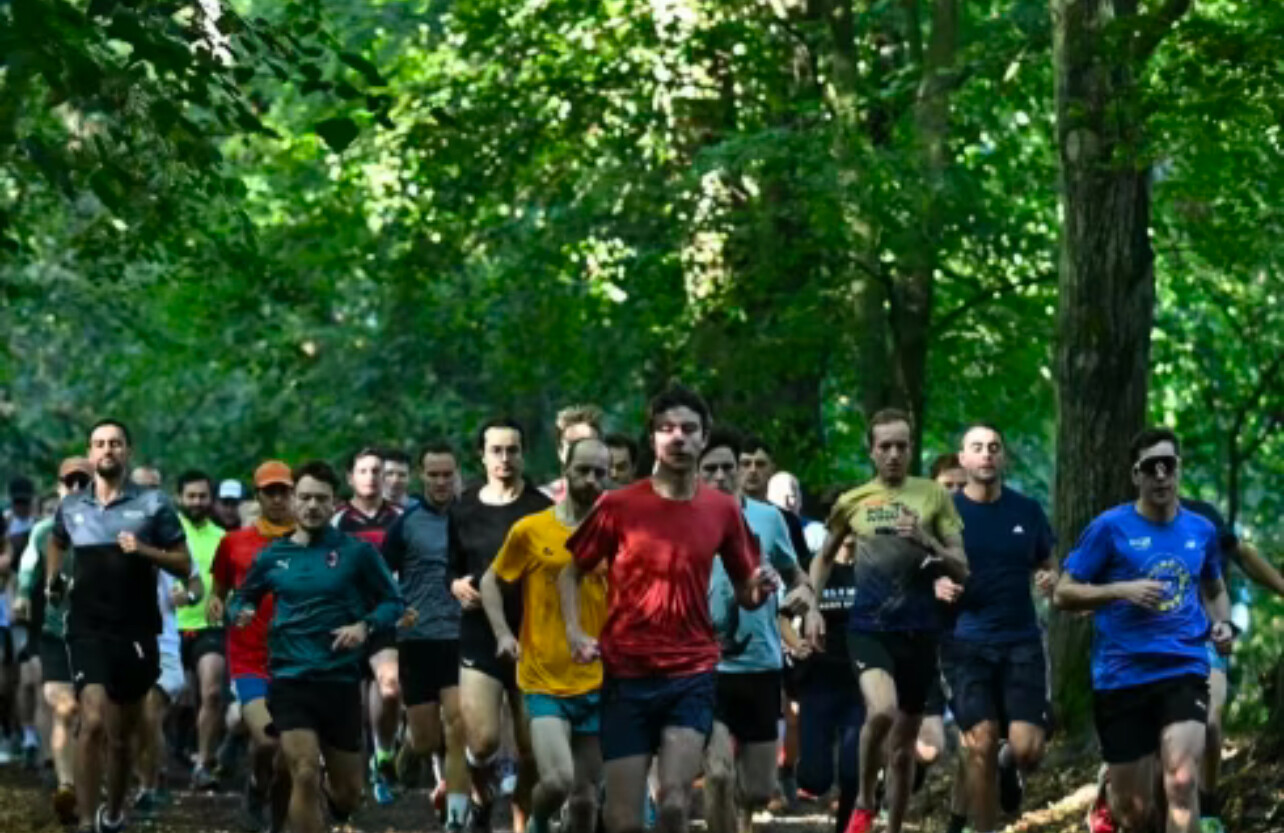
The Parkrun Experience
Participating in Parkrun couldn’t be easier. All it requires is a spare Saturday morning, a comfortable pair of running shoes, and your personalized barcode—a simple phone or watch-based system that tracks your performance across any Parkrun event worldwide. It’s a seamless way to stay active during your travels while engaging with locals and like-minded runners.
Each event follows a similar format: a 5-kilometer route through parks, forests, and scenic trails. Despite its name, Parkrun is inclusive of all abilities—whether you’re running at your fastest pace or enjoying a casual walk. The emphasis is on participation rather than competition. Many runners describe the experience as a celebration of movement and community rather than a typical race.
For travelers, Parkrun offers a chance to explore unique spaces that often lie beyond the standard guidebook recommendations. Whether it's a historic park in London, a scenic trail in Cape Town, or a beachfront route in Sydney, you’ll be immersing yourself in the local landscape.
Building Global Connections

Beyond the physical activity, Parkrun fosters a sense of global connection. Every event is volunteer-led, with locals stepping up to organize, cheer, and support participants. This welcoming atmosphere gives travelers an authentic glimpse into a city’s culture and its people. You may even find yourself sharing post-run conversations over coffee at a nearby café, creating memories and connections that extend far beyond the run.
Regulars often say the most rewarding aspect of Parkrun is its community spirit. While some participants use it to track personal milestones, many simply relish the opportunity to be part of something bigger—a worldwide network of runners, walkers, and volunteers united by a shared goal of inclusivity and health.
Why Parkrun Matters
In a world increasingly focused on well-being, Parkrun has emerged as a pioneering model for combining fitness, mental health, and social inclusion. Studies have shown that running, even at a relaxed pace, can reduce stress, improve mood, and boost overall physical health. The no-cost and no-pressure environment of Parkrun makes it especially appealing to those who might shy away from more competitive or structured events.
For cities, hosting Parkrun events creates an opportunity to bring communities together, revitalize local parks, and promote active lifestyles. It’s no surprise that governments and health organizations often champion Parkrun as a key initiative for public well-being.
A Must-Do for Travel Enthusiasts
For the traveler looking to experience a destination in a unique way, Parkrun is a hidden gem. It’s a blend of fitness, community, and exploration that allows you to see a city from a different perspective. Whether you’re sprinting along a river in Tokyo or jogging through the vibrant greenery of a Dublin park, the experience is both grounding and exhilarating.
So next time you’re planning a trip, consider penciling in a Parkrun on your Saturday morning itinerary. Pack your running shoes, download your barcode, and get ready to explore the world one 5K at a time. Who knows—you might leave with not just a sense of accomplishment but also a story to tell and a friend or two from across the globe.
(01/23/2025) ⚡AMPby Boris Baron
Ejgayehu Taye and Isaia Lasoi target record times at RAK Half Marathon
Ejgayehu Taye and Isaia Lasoi are leading contenders to follow a quartet of stars who have set world records in the Ras Al Khaimah Half Marathon whose 18th running comes on Saturday, February 1. Taye of Ethiopia and Lasoi of Kenya reckon that they are running into the sort of form that suggests fast times a week Saturday.
World championships bronze medallist indoors and out, and a top eight finisher at the Olympic Games, Taye has rarely raced on the road, but if she can bring her track form to Ras Al Khaimah, she would clearly be a leading contender for victory in 2025; the more so since in her sole performance at the half marathon in Valencia three months ago, she finished ahead of last year’s RAK winner Tsigie Gebrselama.

Taye ran 64min 14sec in Valencia on what her manager reports was less than adequate preparation. Yonas Mekonnon says, ‘Taye decided to try for the world record based on her recent training. RAK ‘half’ will be her second half marathon and when she compared both training based on the quality and volume, the hope for RAK half is much better. She ran just over 64minutes in Valencia without good enough mileage. She was trained really for not more than six weeks after the track season was over and the longest training was 25km. However, this time she’s regularly been covering more than 28km with 3min 30sec pace at altitude. Her goal in this race is the world record’.
The Ras Al Khaimah Half Marathon has regularly returned world record times since Sammy Wanjiru of Kenya ran 58min 53sec in the inaugural event in 2007. The women then took over with luminaries like Mary Keitany, Peres Chepchirchir and Ababel Yeshaneh setting women’s records during the last decade. But such have been the advances in shoe technology and the boost of energy gels in the interim that the current men’s record is over a minute faster, with the 57:30 that Yomif Kejelcha clocked in Valencia three months ago. The women’s record is an equally formidable 62:52 set by his colleague Letesenbet Gidey at the same race over three years ago.
In contrast, the RAK record is eminently breachable, at least on the women’s side. As it happens, Taye’s debut 64:14 is exactly the same as the RAK course record time, set in 2022 by another colleague Girmawit Gebrzihair who runs again next weekend. Gebrzihair looks to be in prime form too, following a rapid 29:34 for the Valencia 10k on January 12.

In the men’s race, Lasoi is hoping to emulate recent top three finishers who returned to win the following year. Lasoi came through for third last year, and is nothing if not ambitious. He clocked 58:10 in Copenhagen last autumn, and stated badly afterwards, ‘Eager to run 57 minutes in half marathon in future’.
This is the second year that RAK half-marathon will be overseen by Pace Events, long time organiser of the neighbouring Dubai Marathon. Race Director Peter Connerton says, ‘We’re looking to build on the success of last year’s event, and continue to bring both fast, exciting elite racing to Ras Al Khaimah, in addition to a well-supported popular race, supported by the community’.
(01/23/2025) ⚡AMPRak Half Marathon
The Rak Al Khaimah Half Marathon is the 'world's fastest half marathon' because if you take the top 10 fastest times recorded in RAK for men (and the same for women) and find the average (for each) and then do the same with the top ten fastest recorded times across all races (you can reference the IAAF for this), the...
more...Sandra Folzer, 85, Shatters Indoor Mile World Record for Her Age Group
At 85 years young, Sandra Folzer is proving that age is just a number. Over the weekend, the Chestnut Hill resident etched her name into the history books by setting a new indoor mile world record for the 85-89 age group.
Folzer completed the mile in an impressive 9 minutes and 45 seconds, outpacing the previous record by a remarkable 29 seconds. Her incredible feat demonstrates not just physical stamina but also a testament to dedication and determination.

Despite her historic achievement, Folzer believes she hasn’t yet reached her full potential. “I could have gone faster,” she remarked, showing the same drive that brought her to this record-breaking moment.
A local icon in Chestnut Hill, Folzer’s accomplishment inspires runners of all ages. Her story highlights that there is no limit to what the human spirit can achieve, no matter your stage in life.
For Sandra Folzer, the finish line is just the beginning. With plenty of laps left in her, the world will be watching to see what she conquers next.
(01/22/2025) ⚡AMPby Boris Baron









